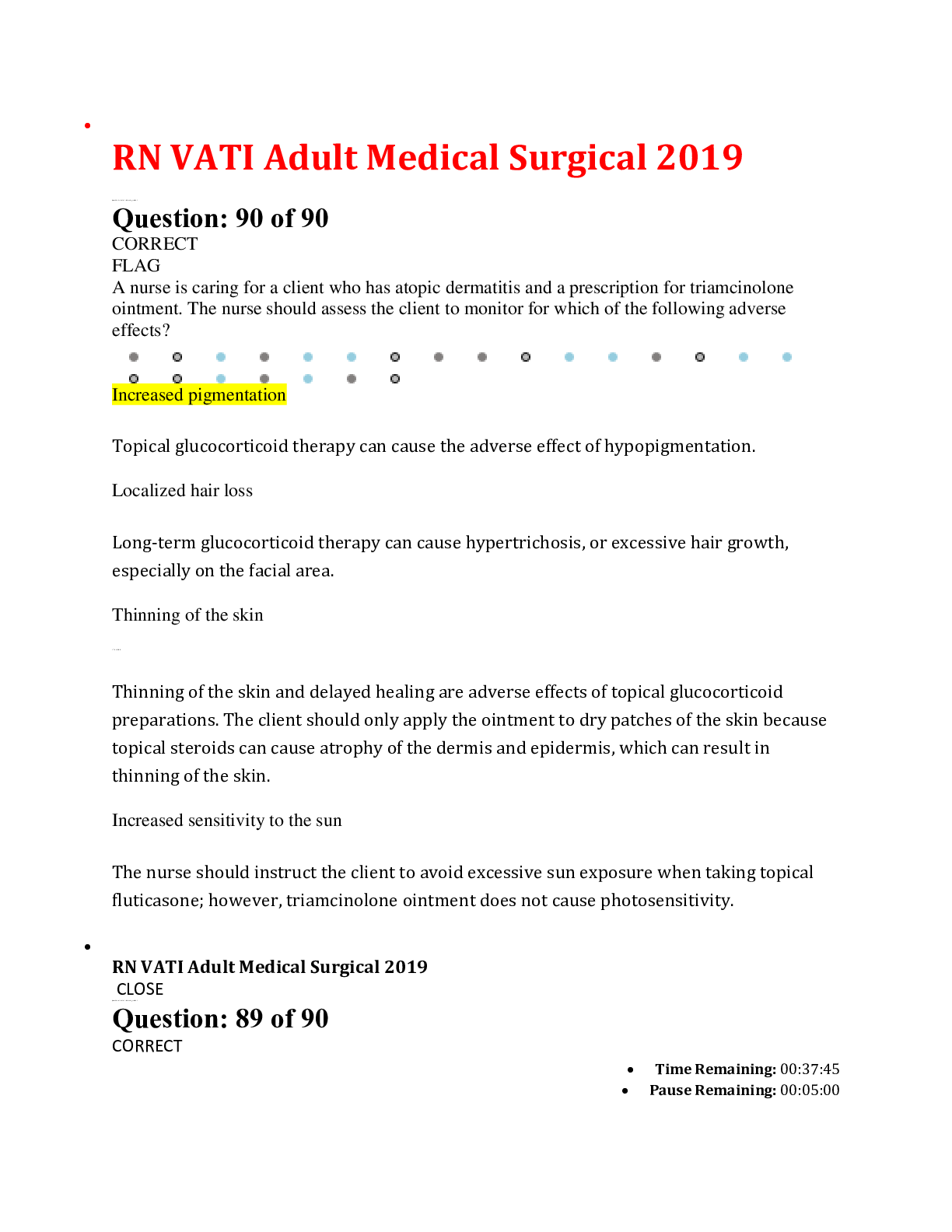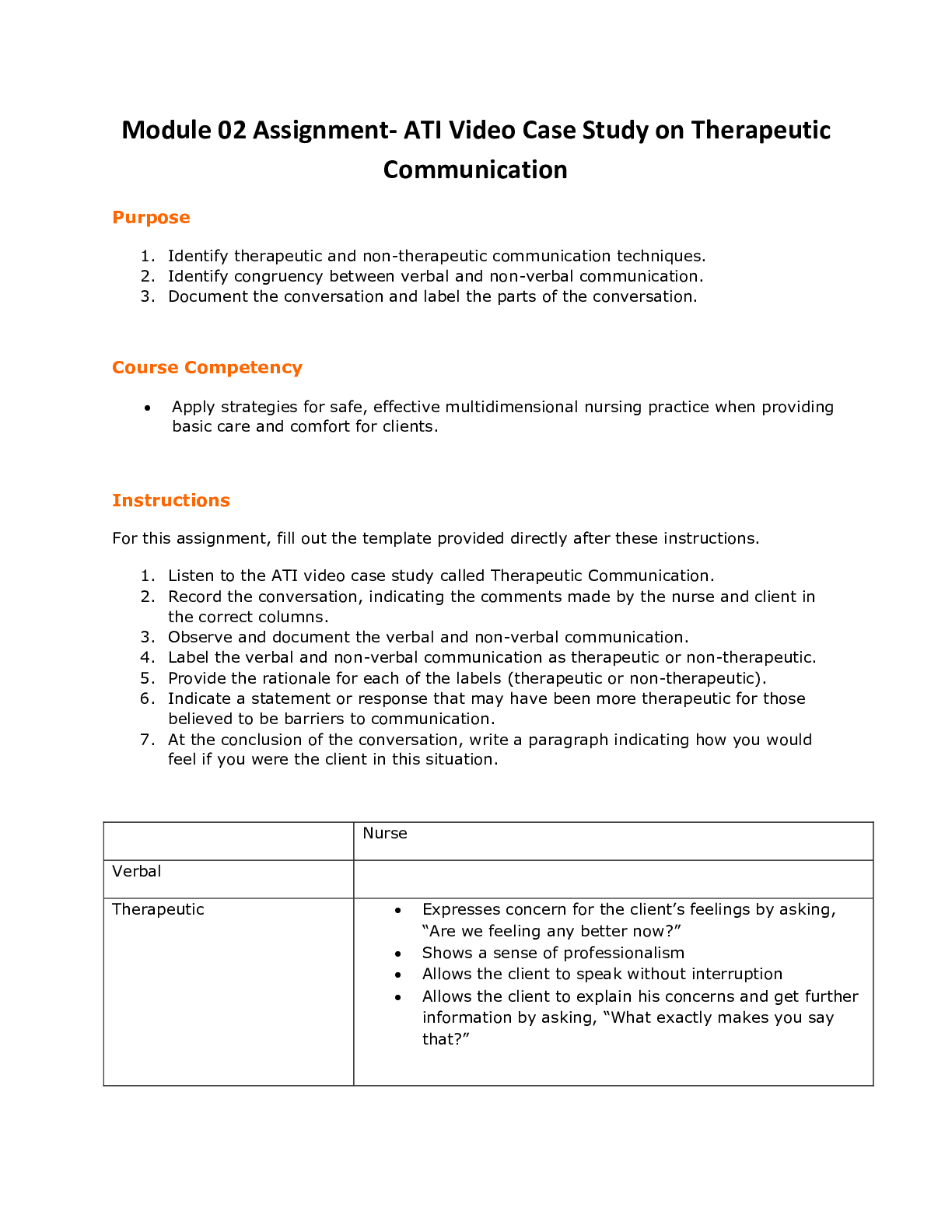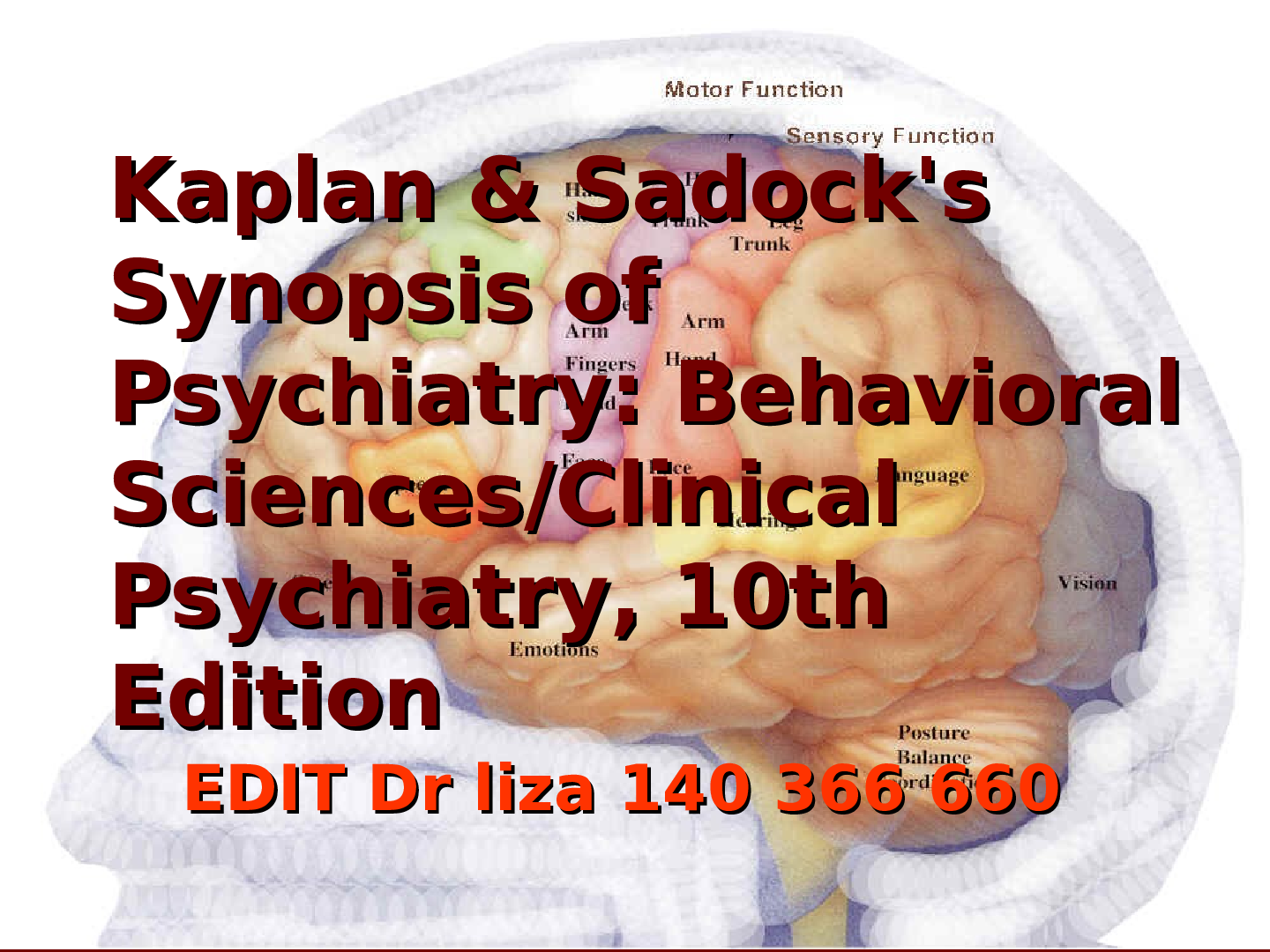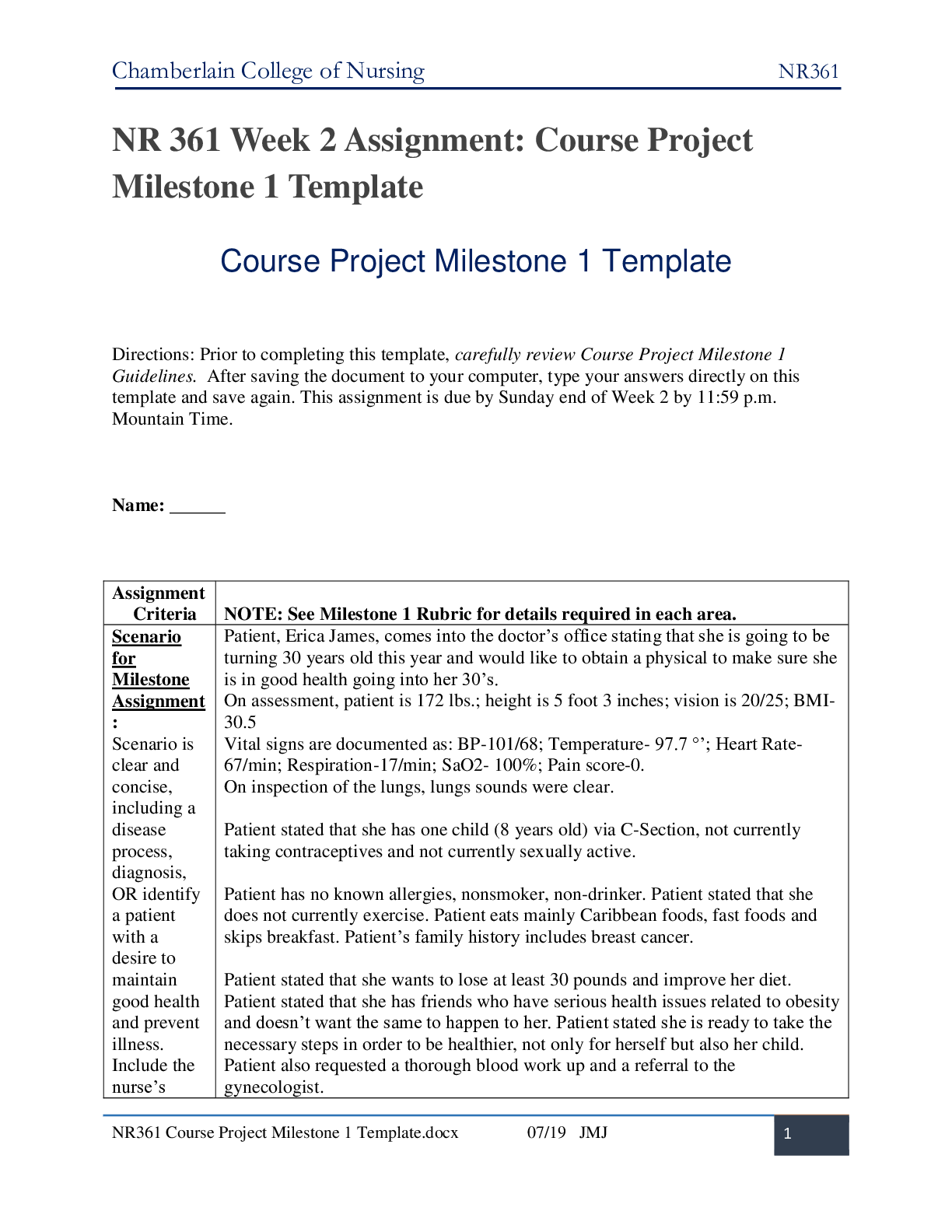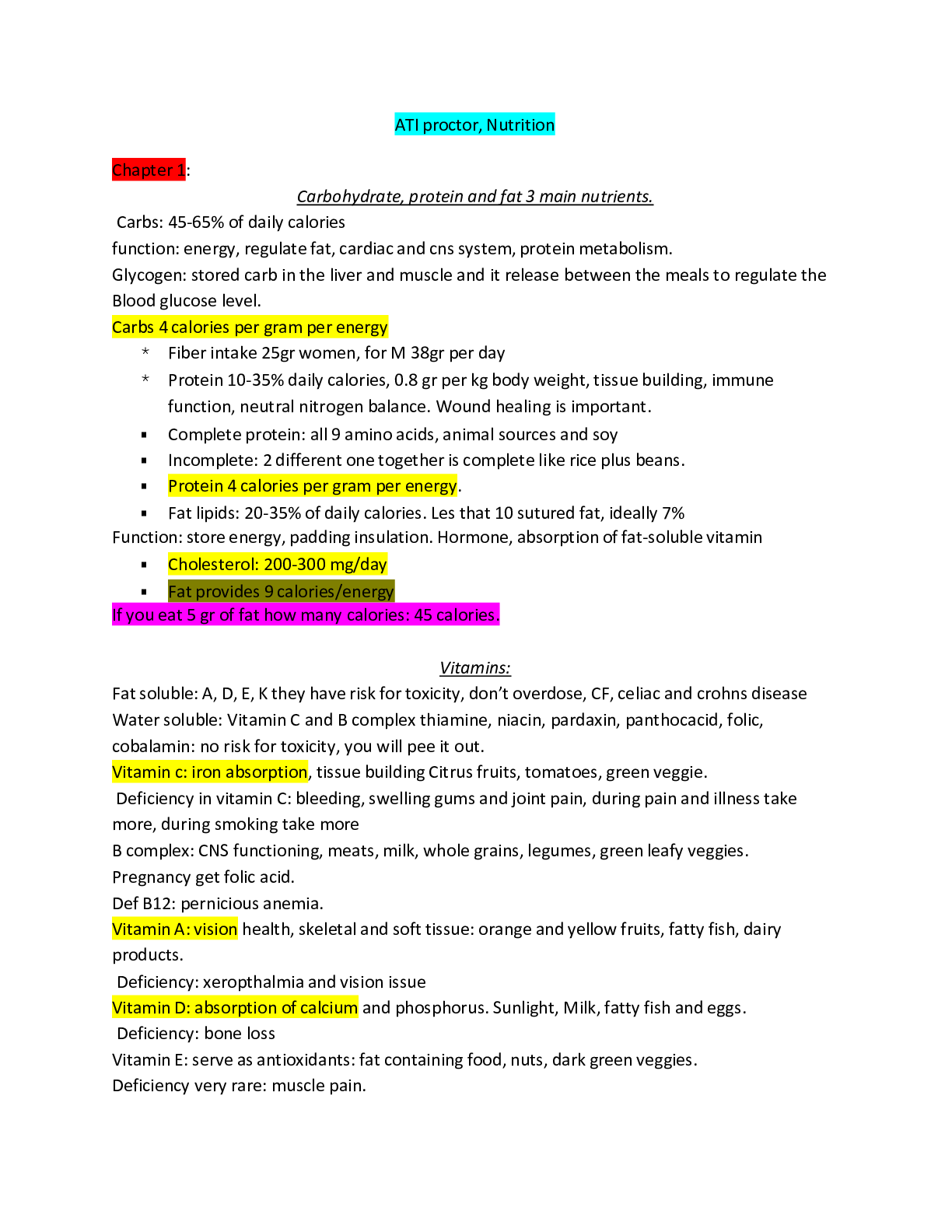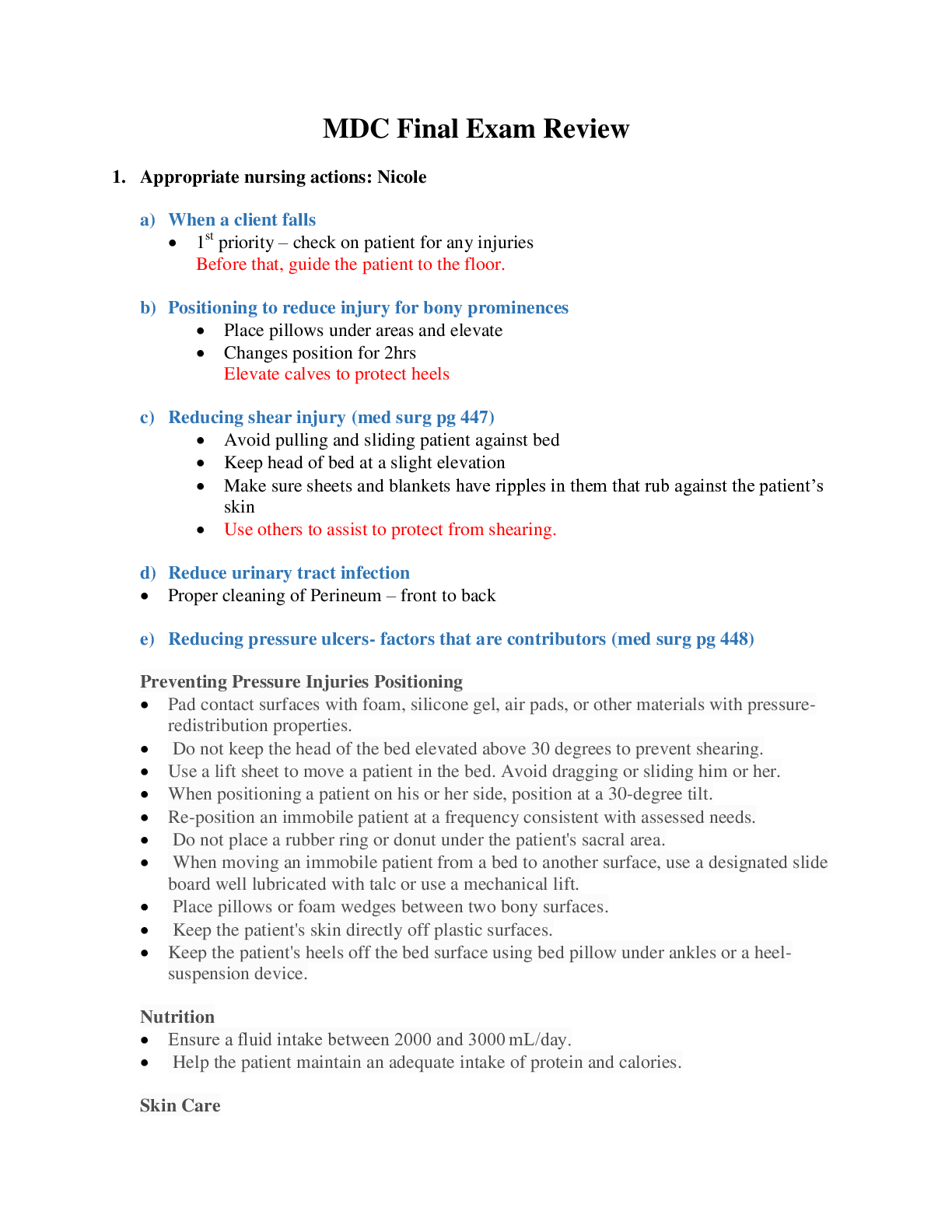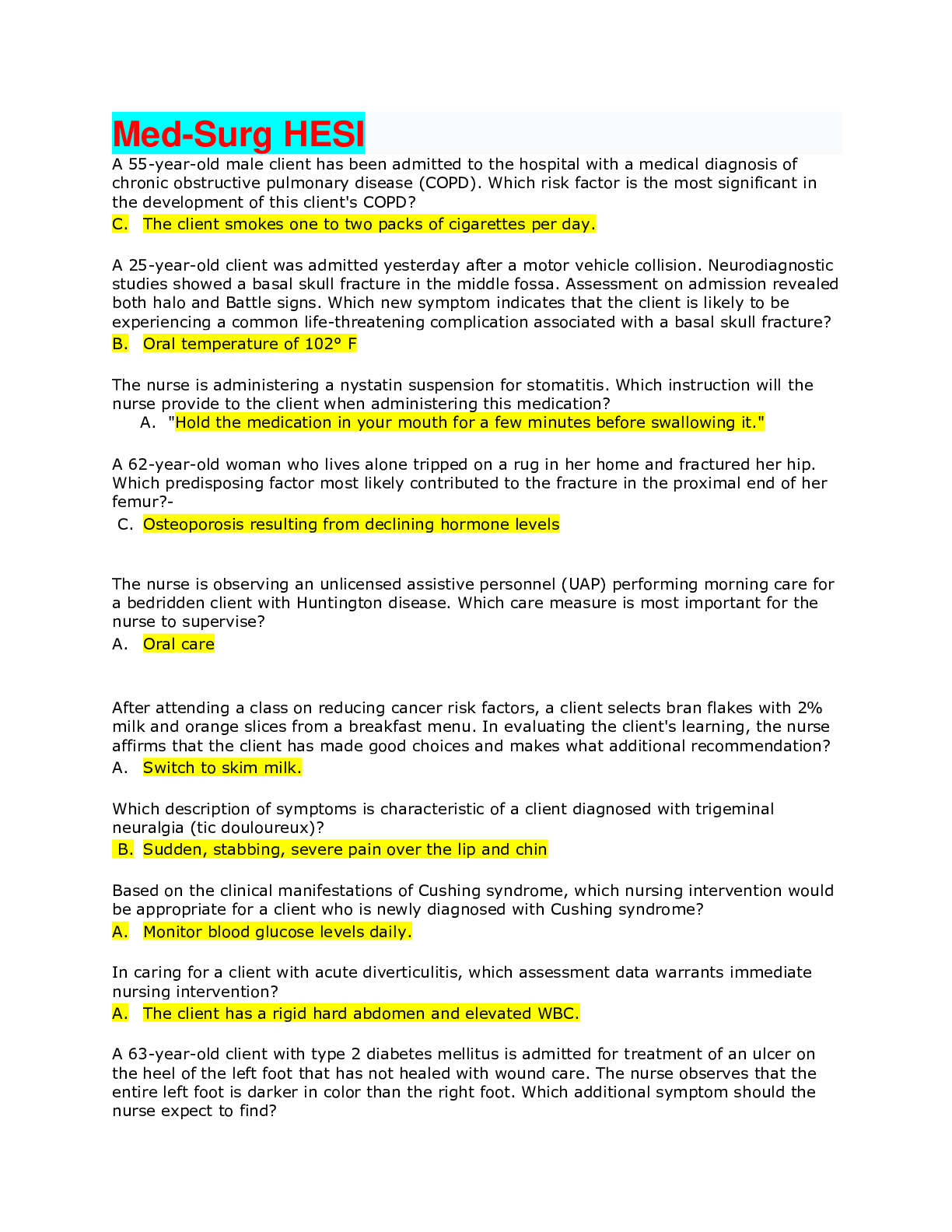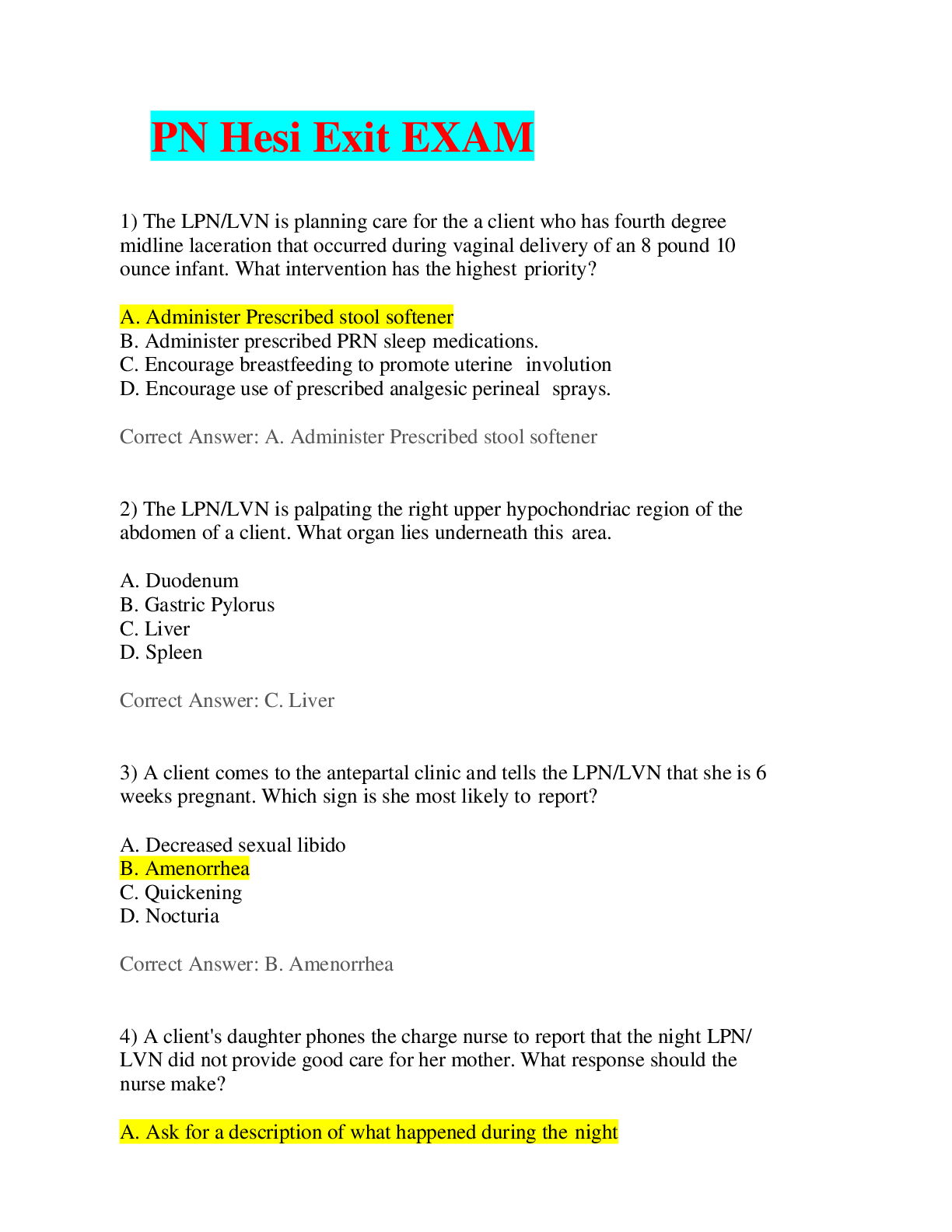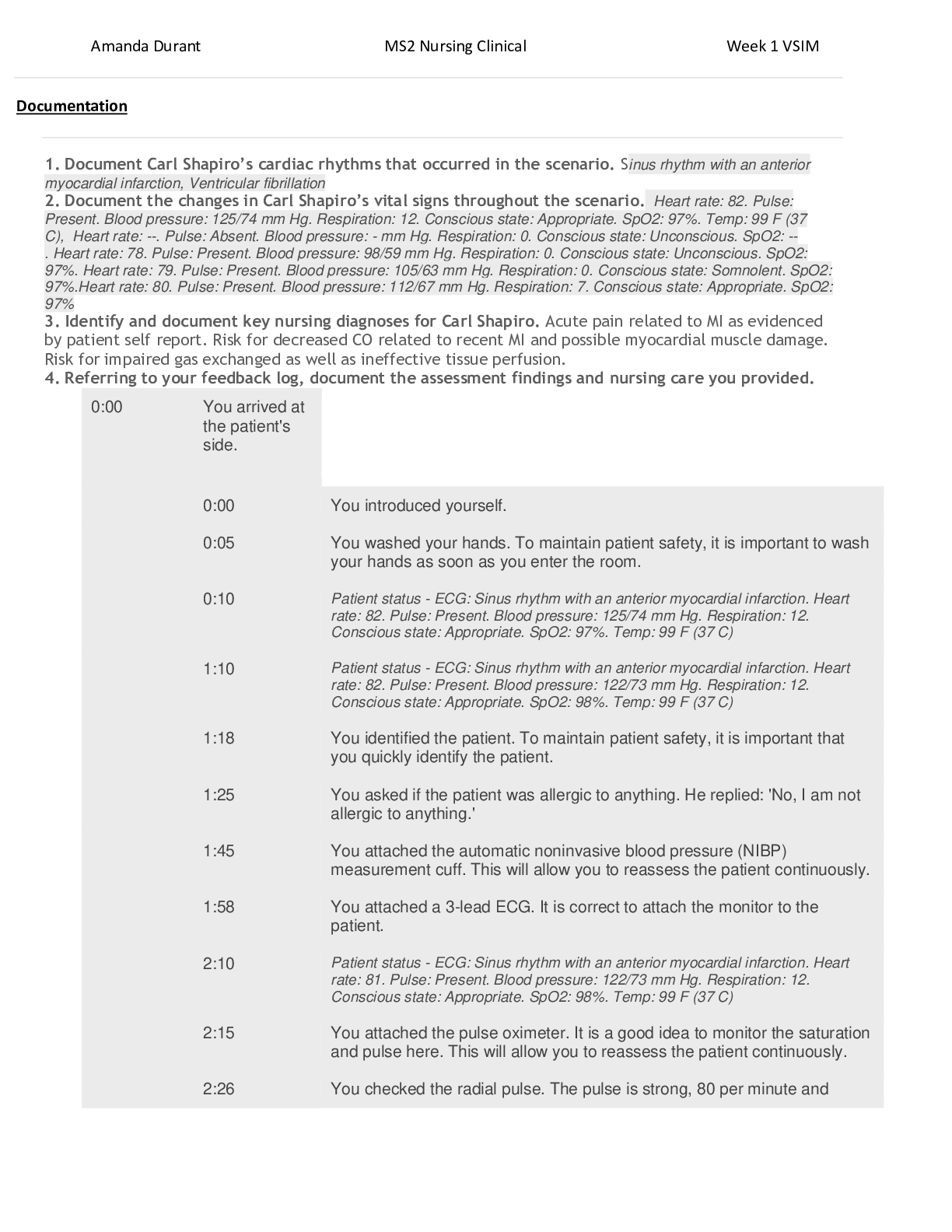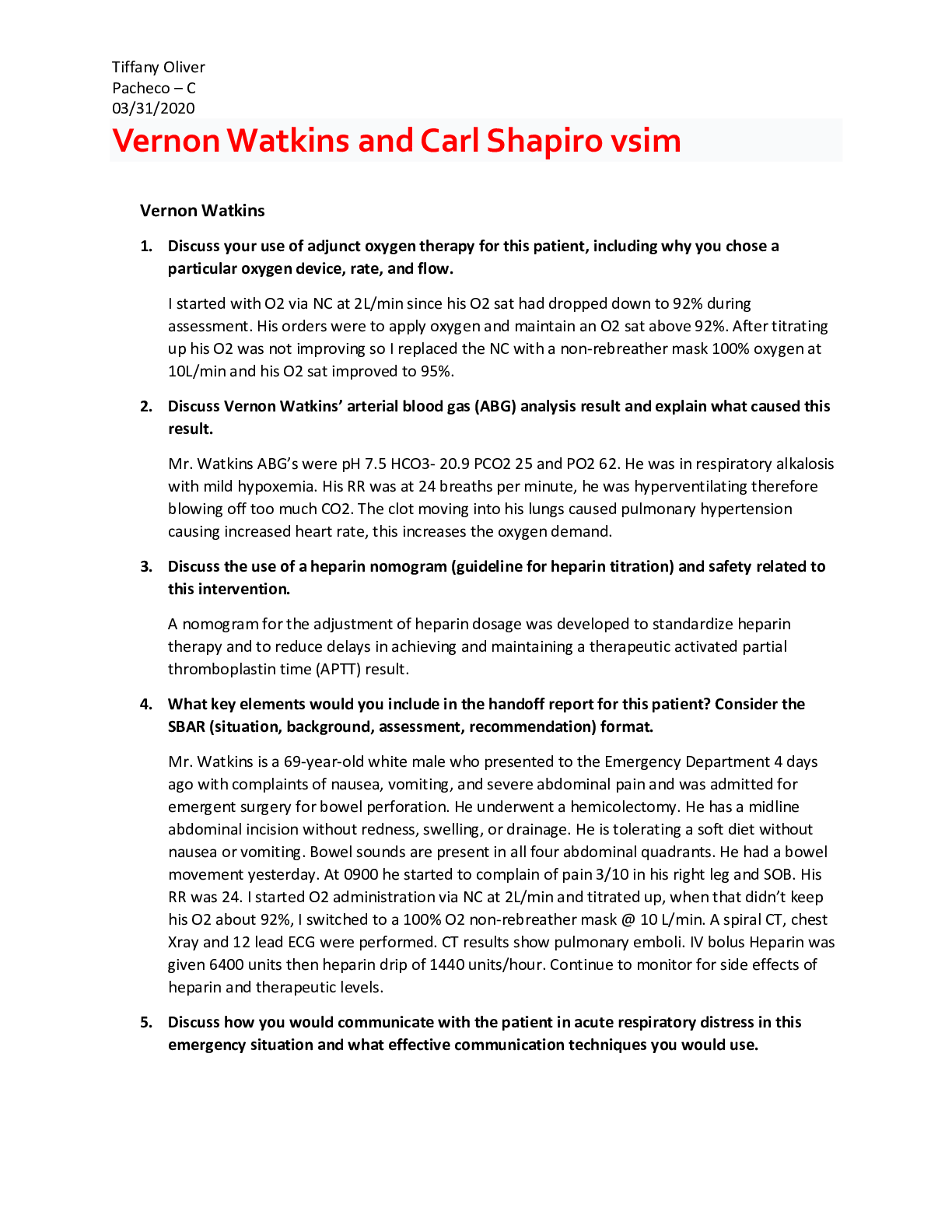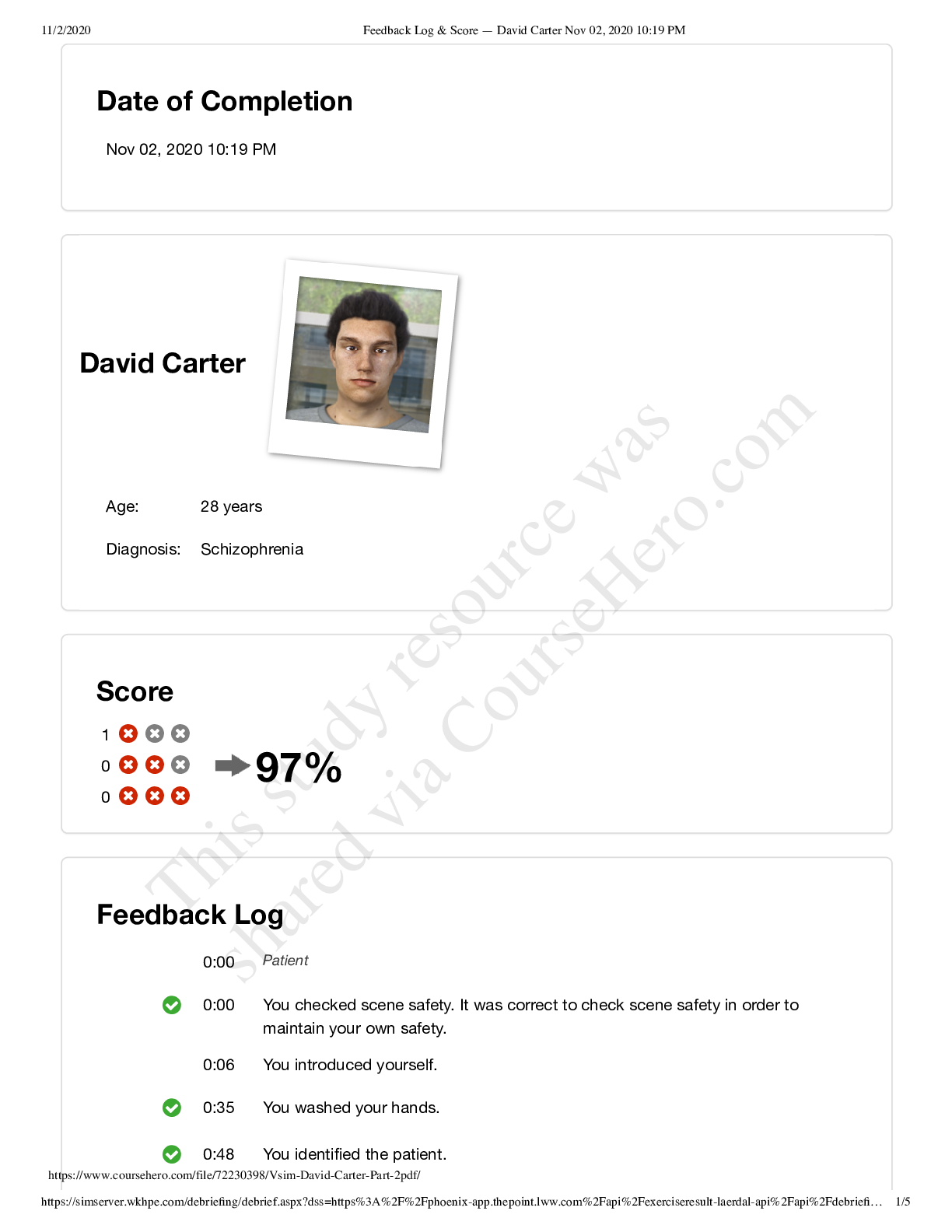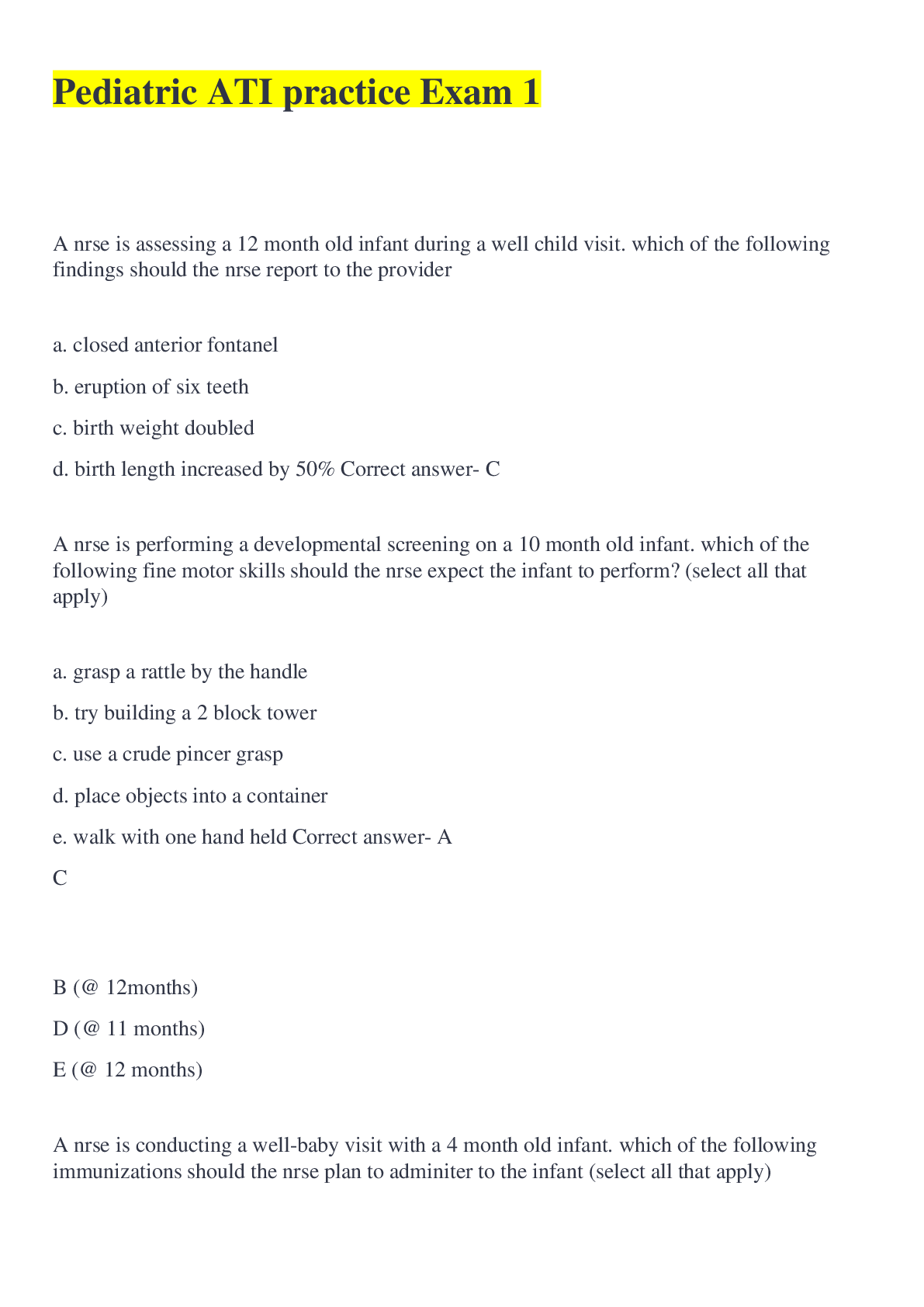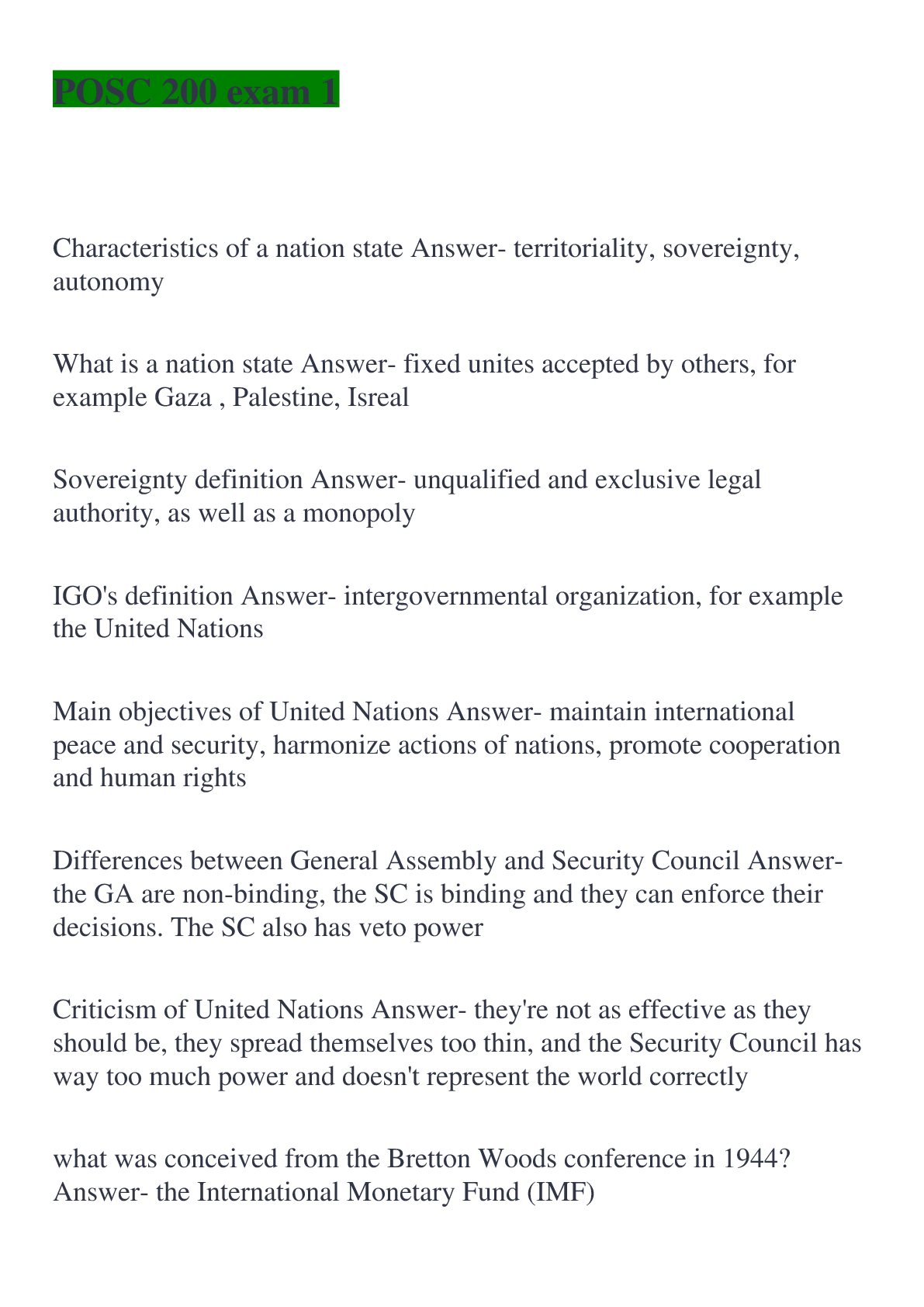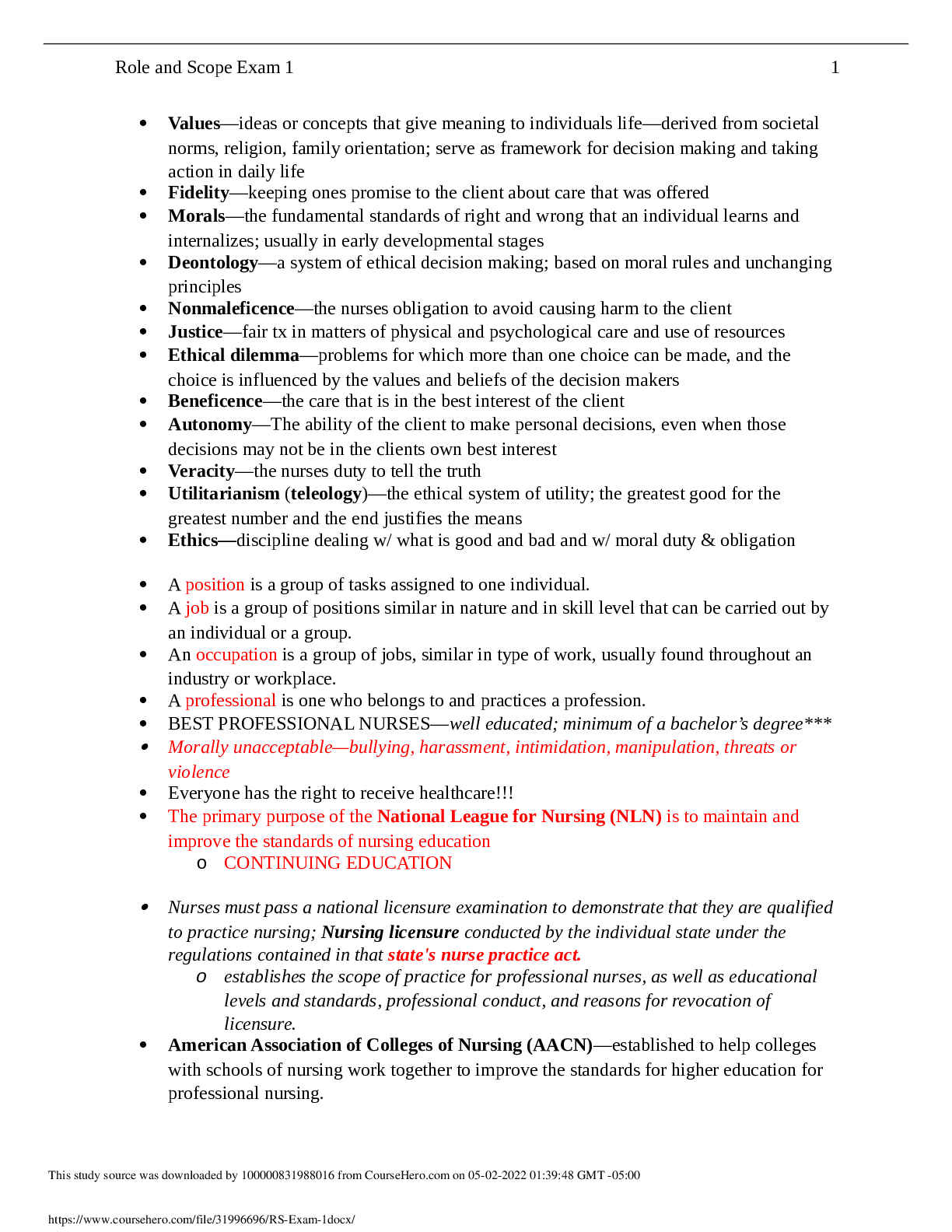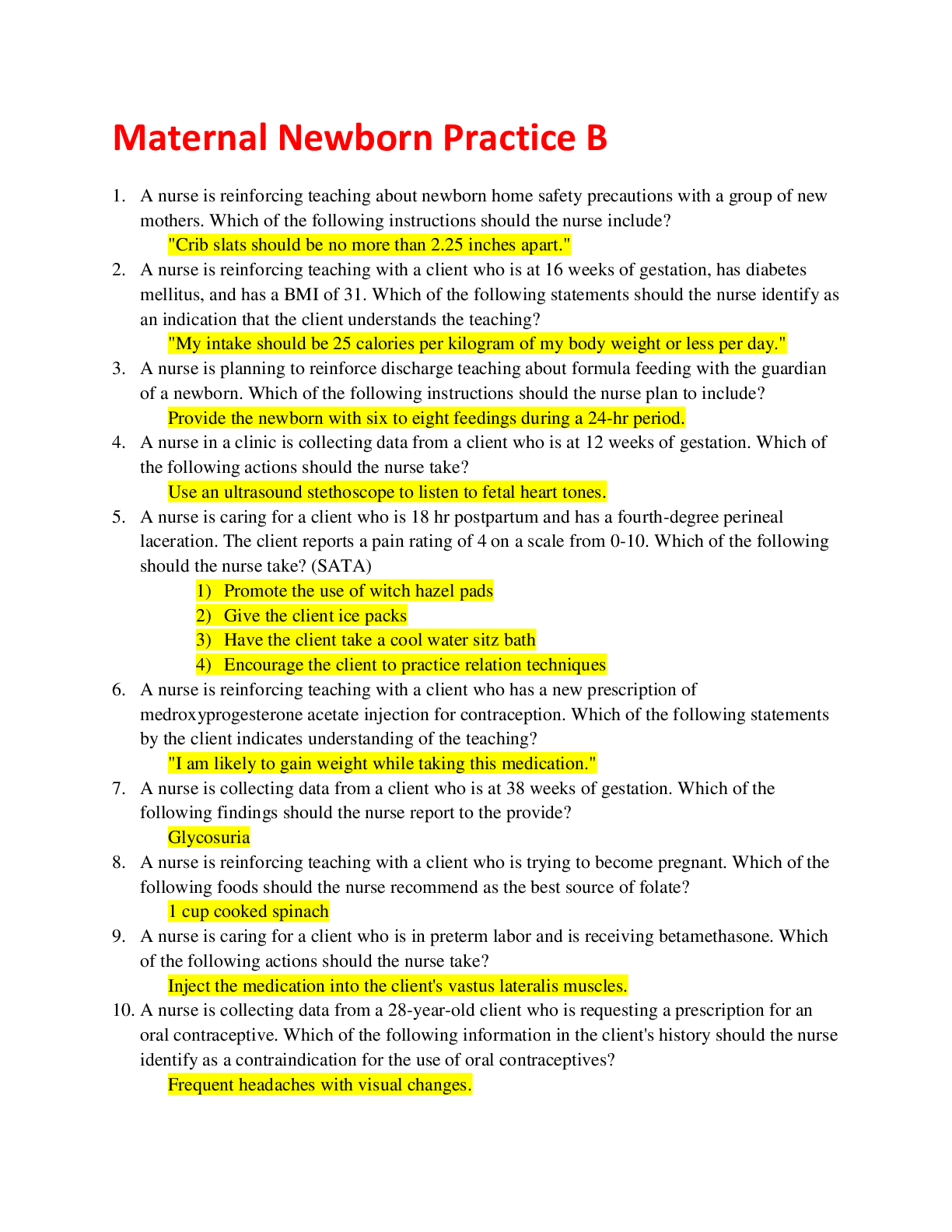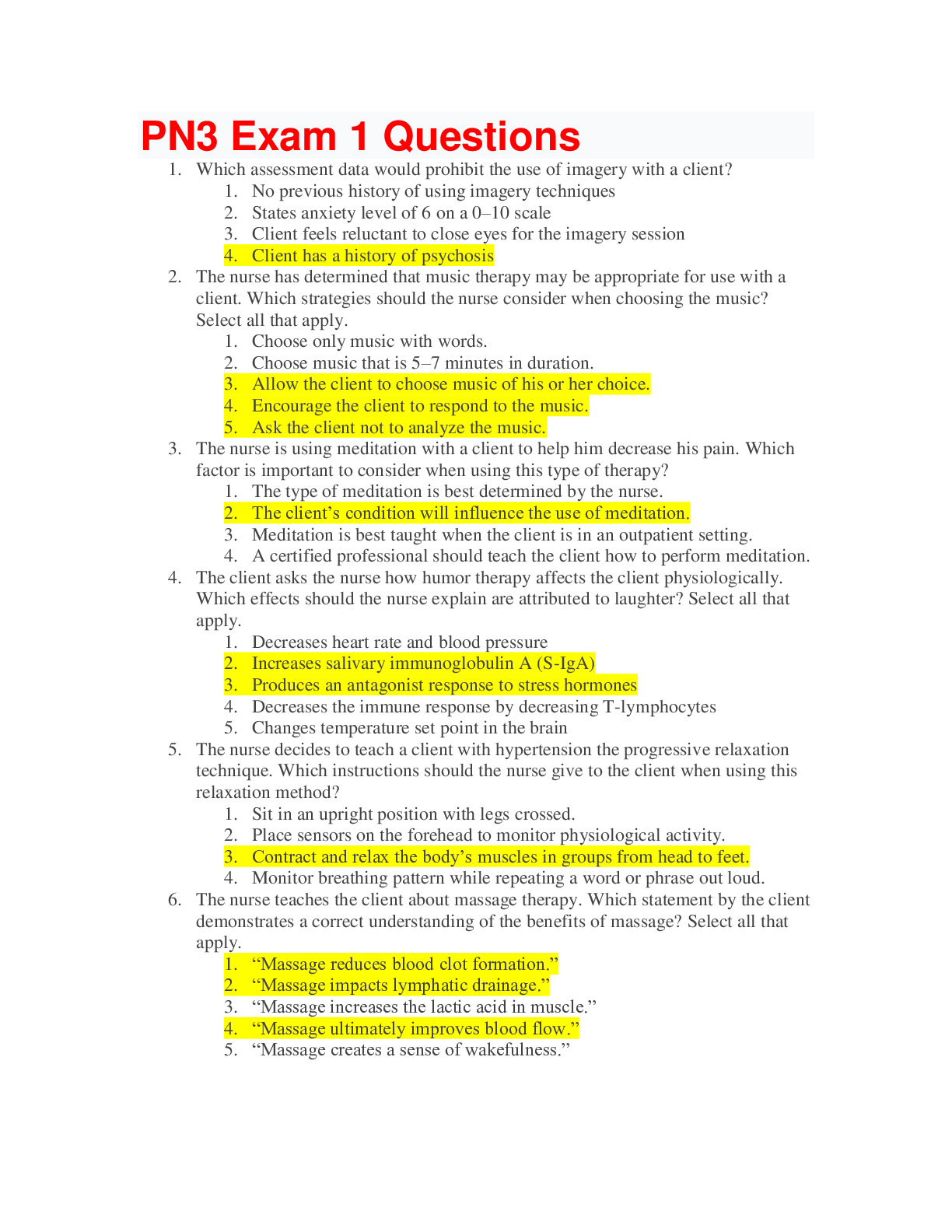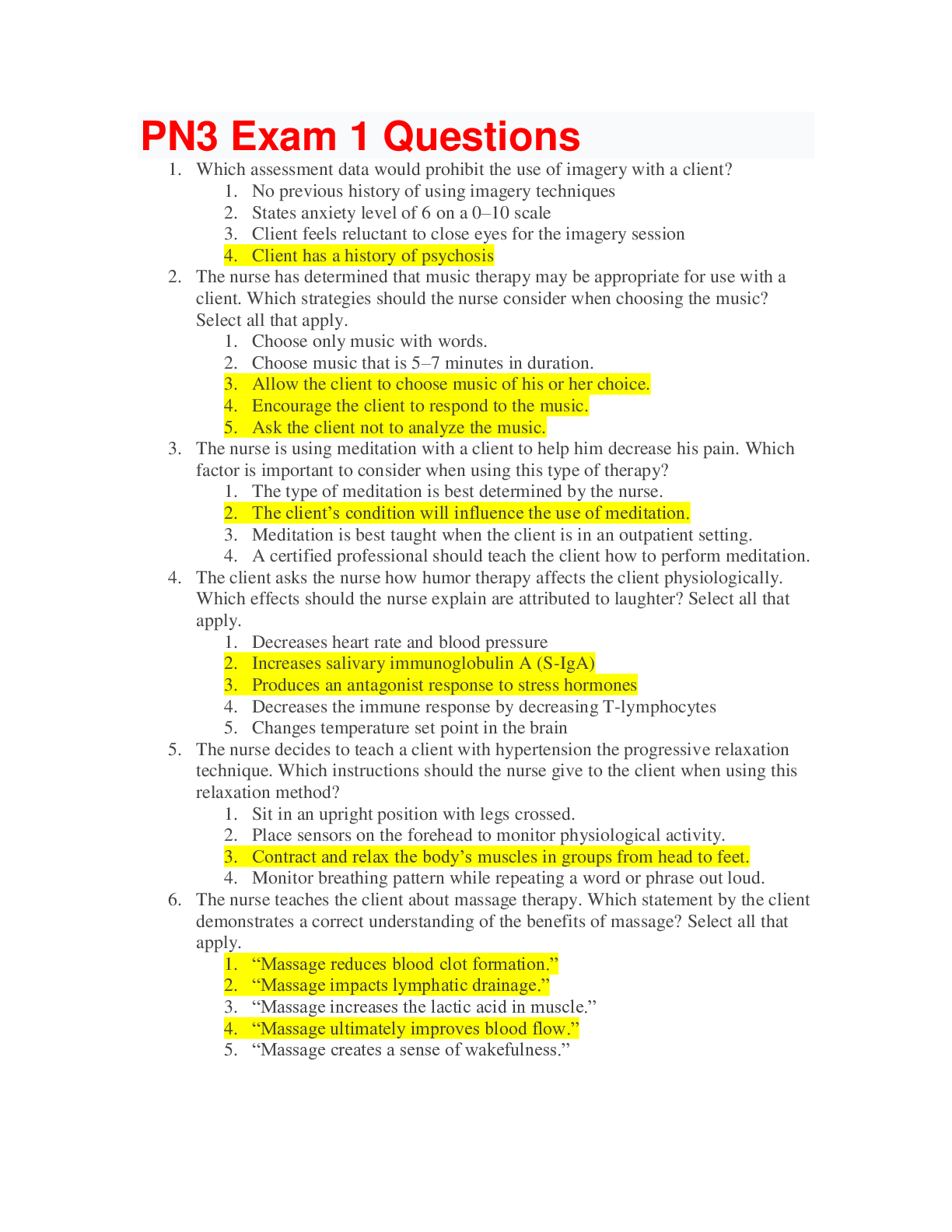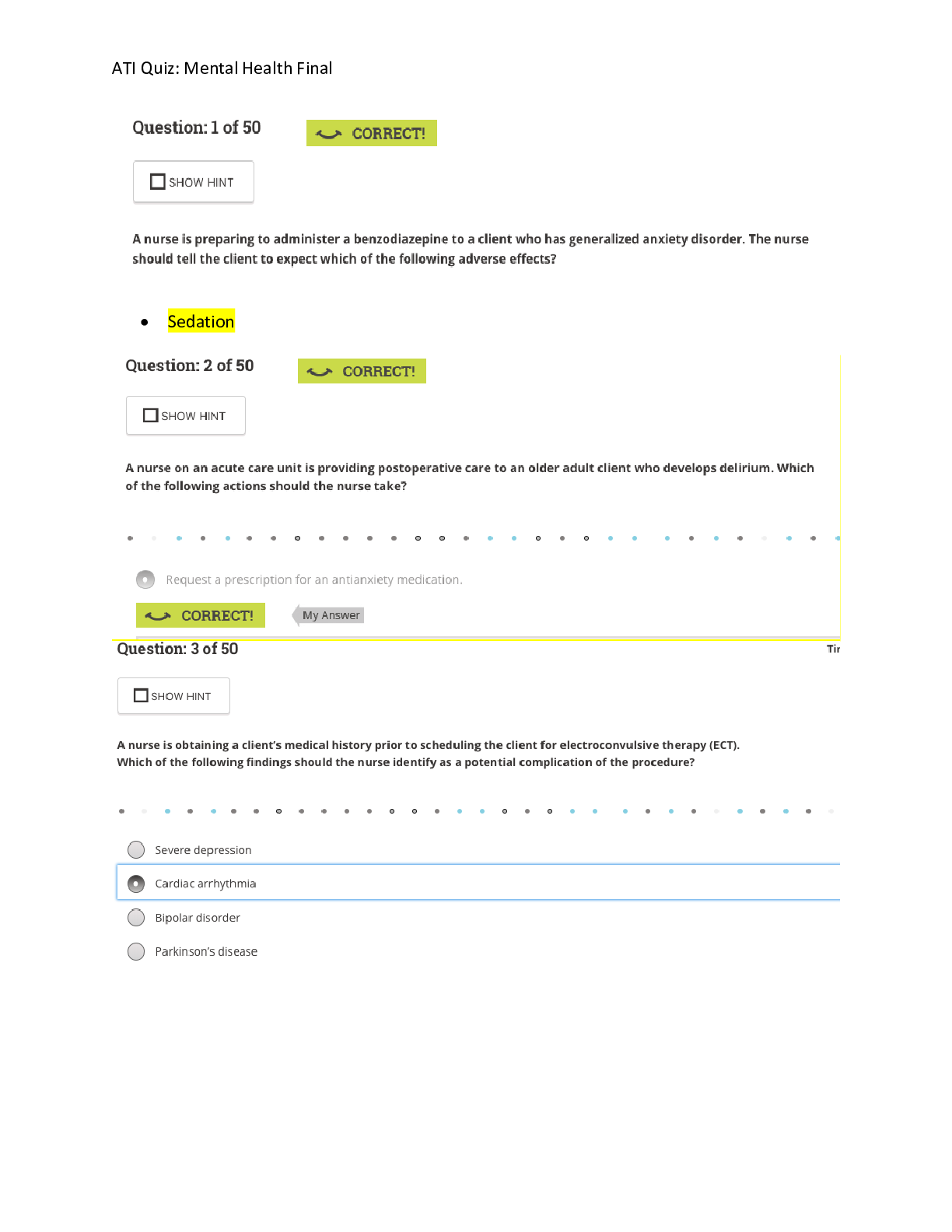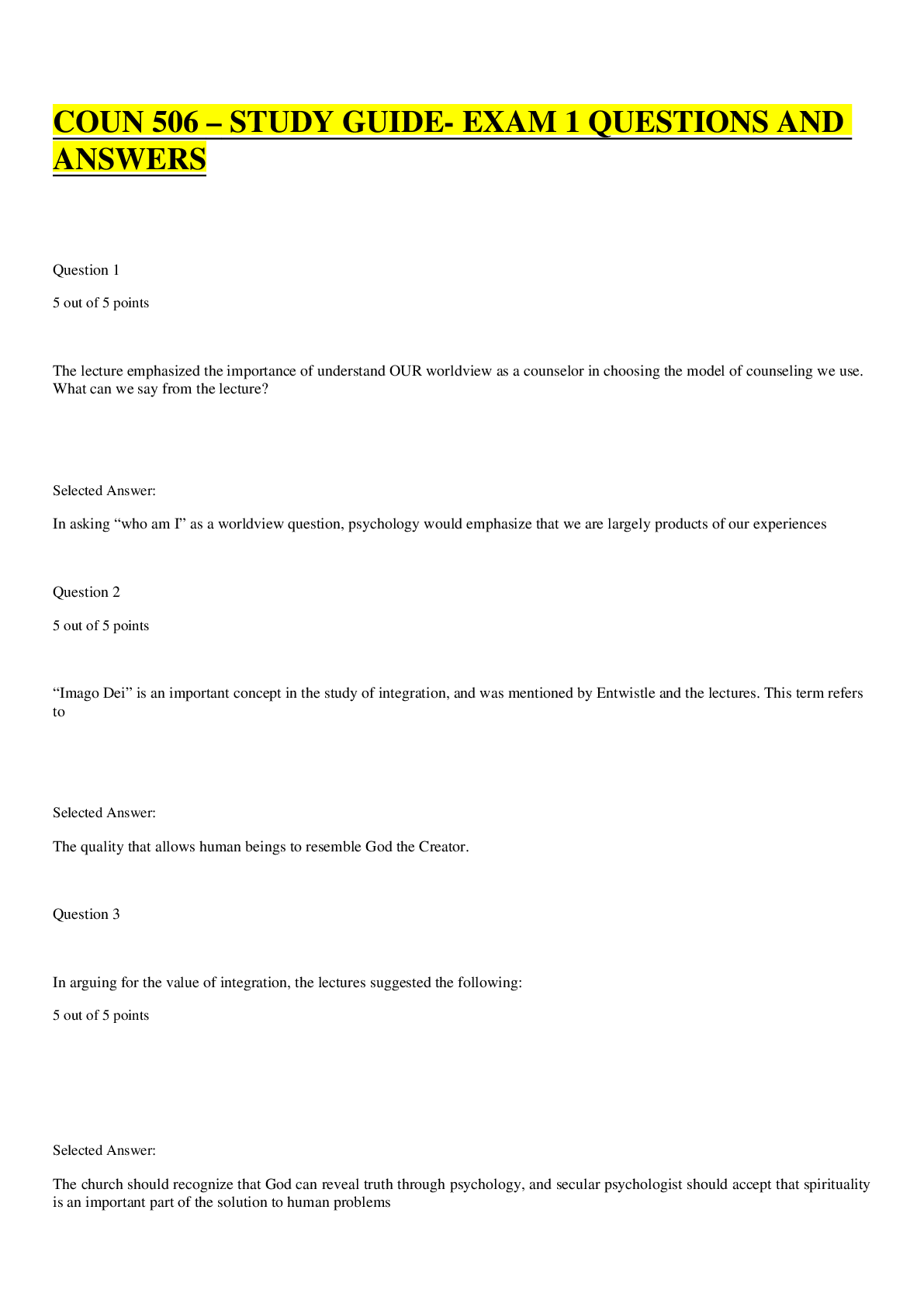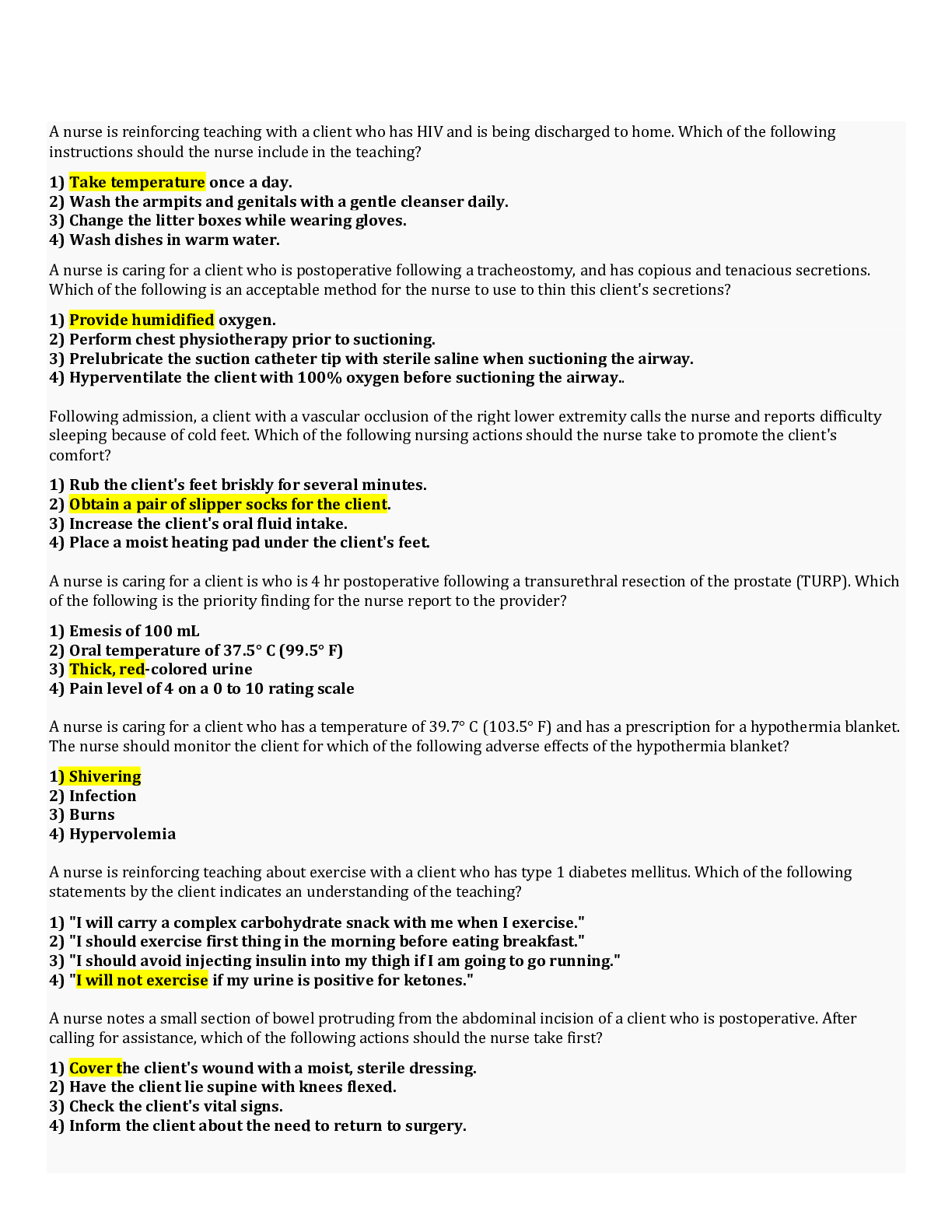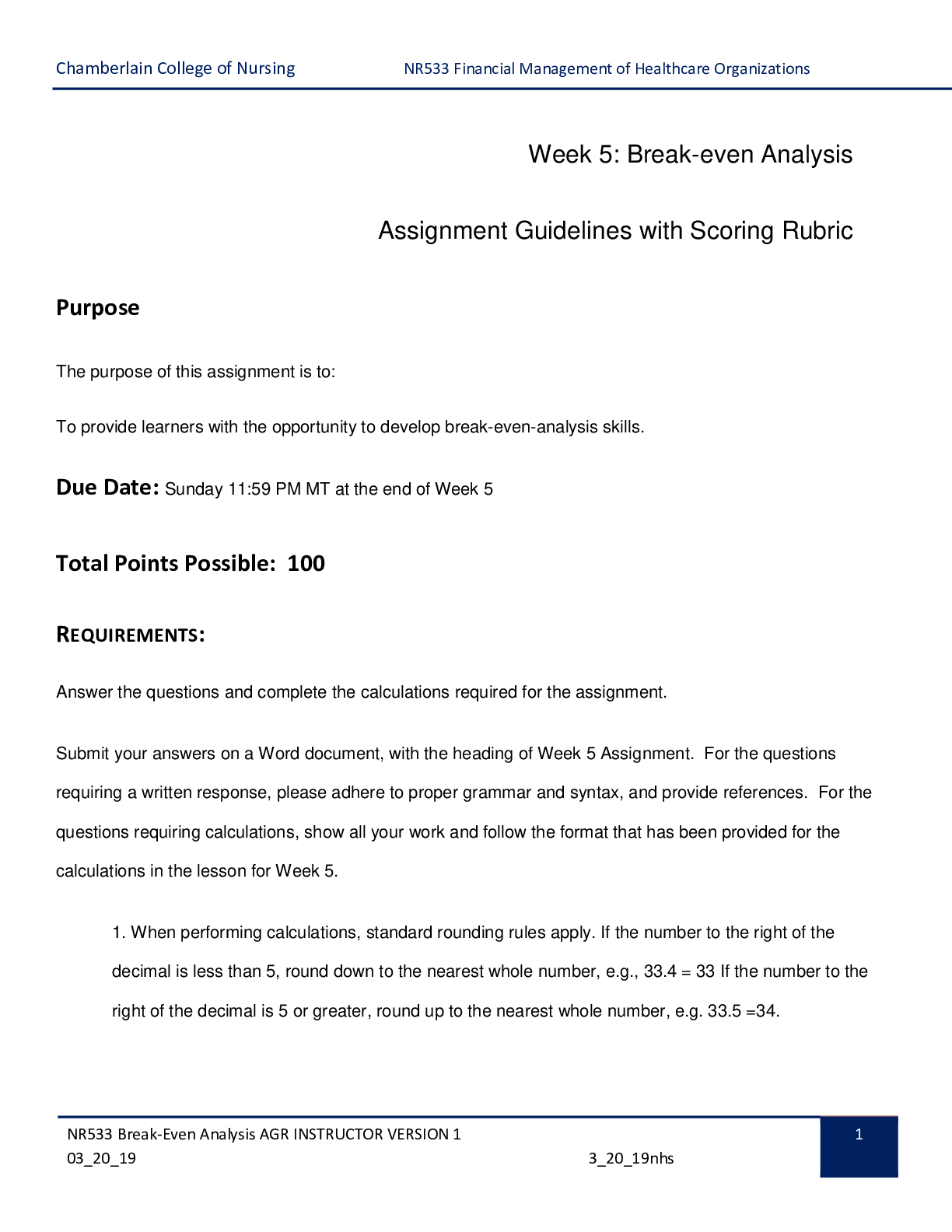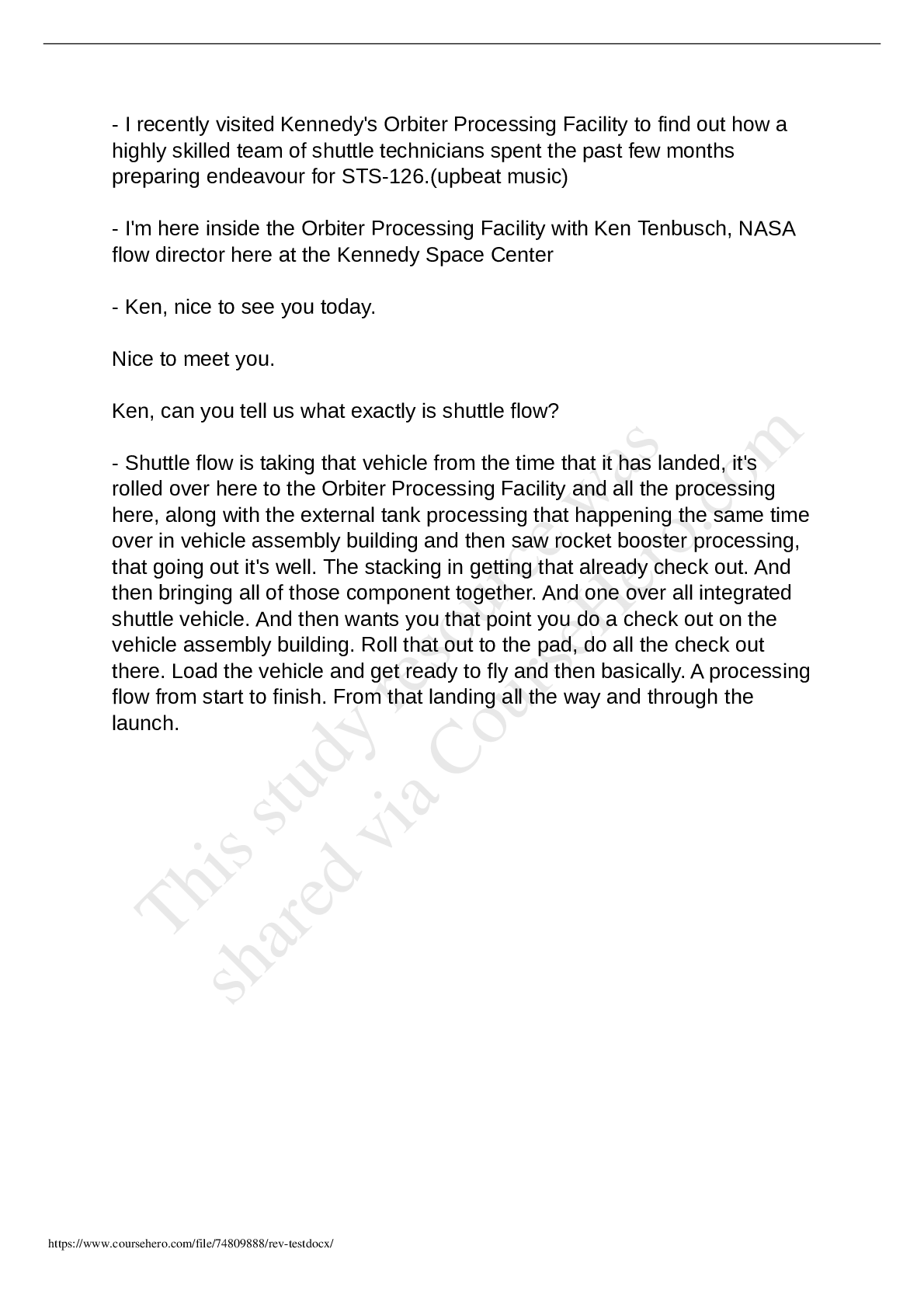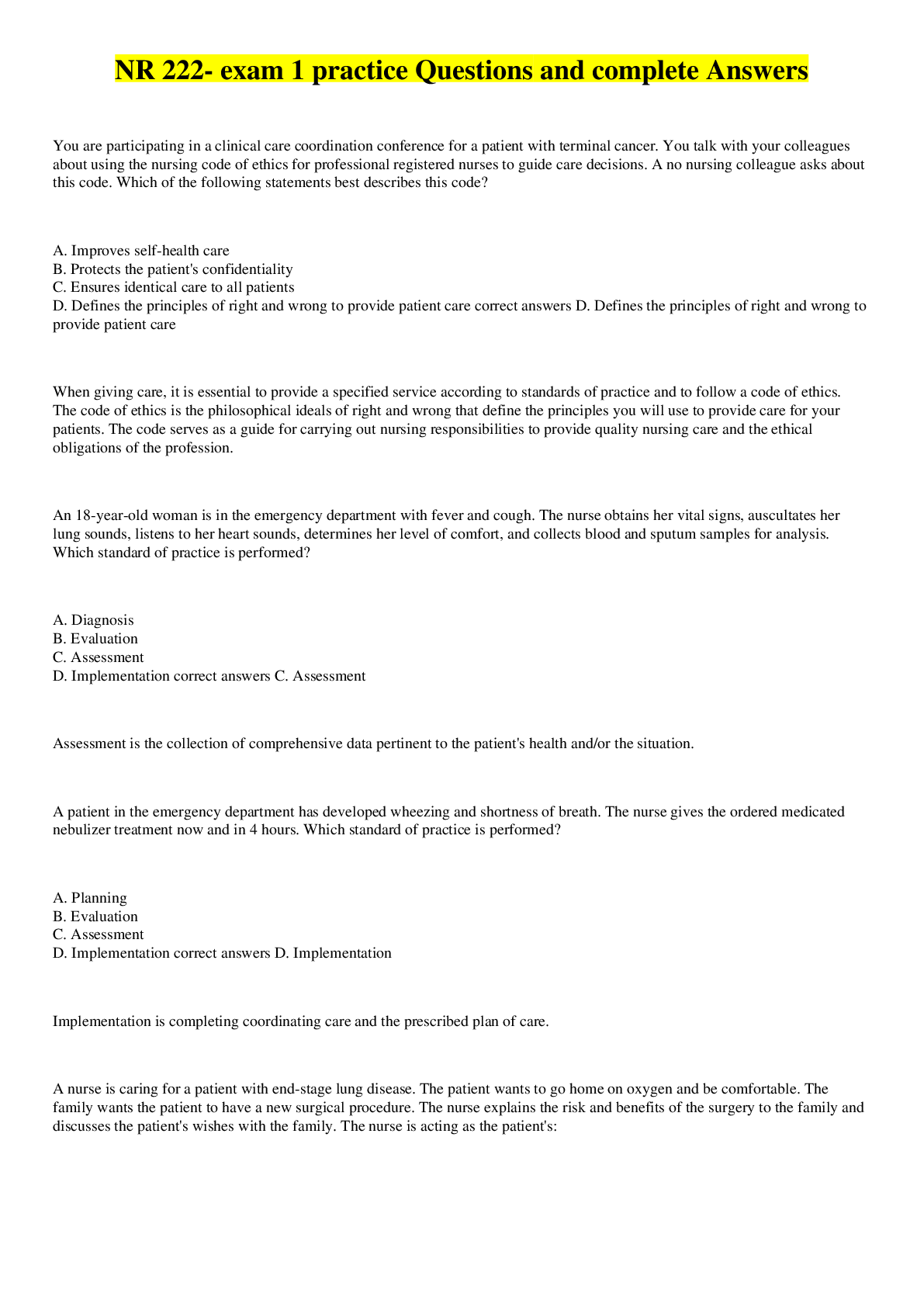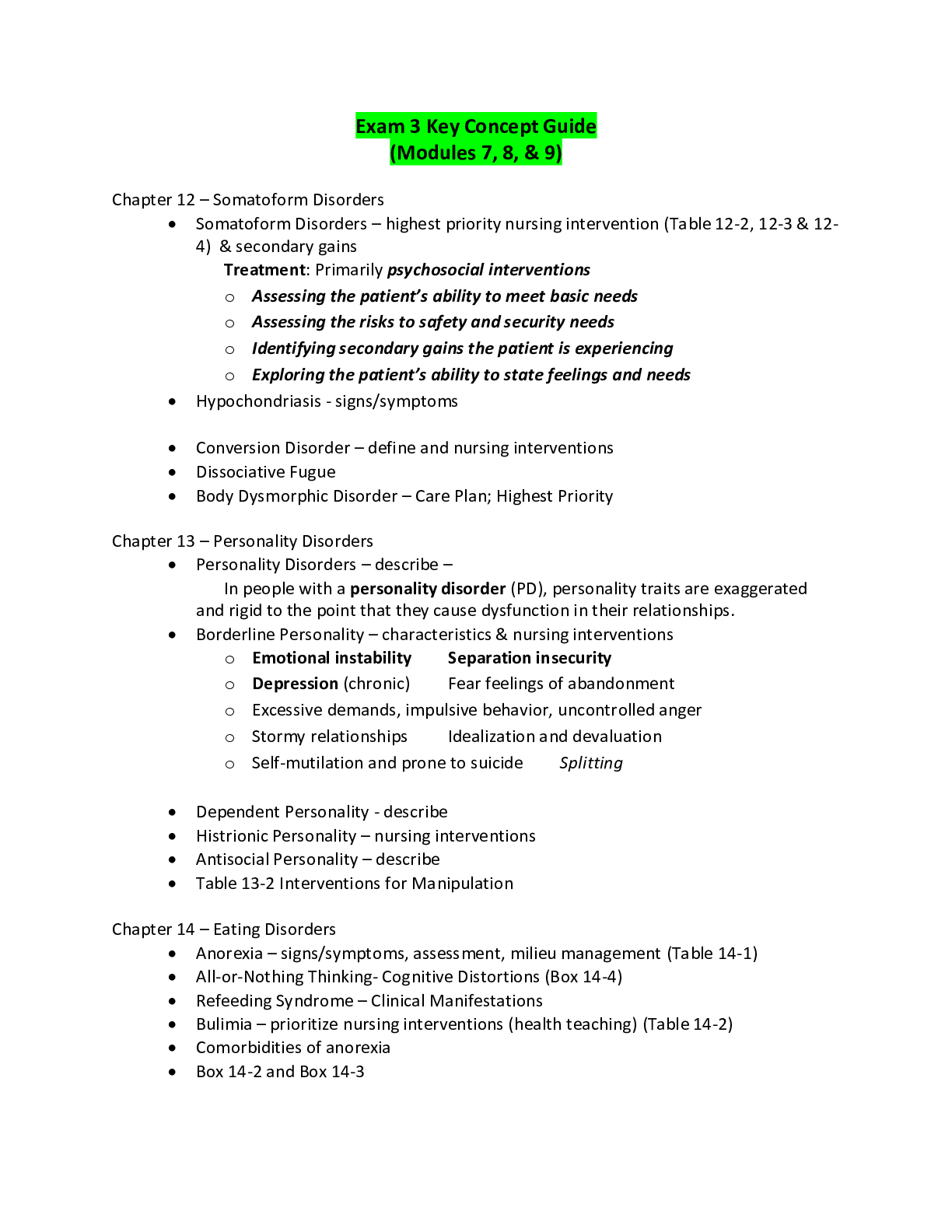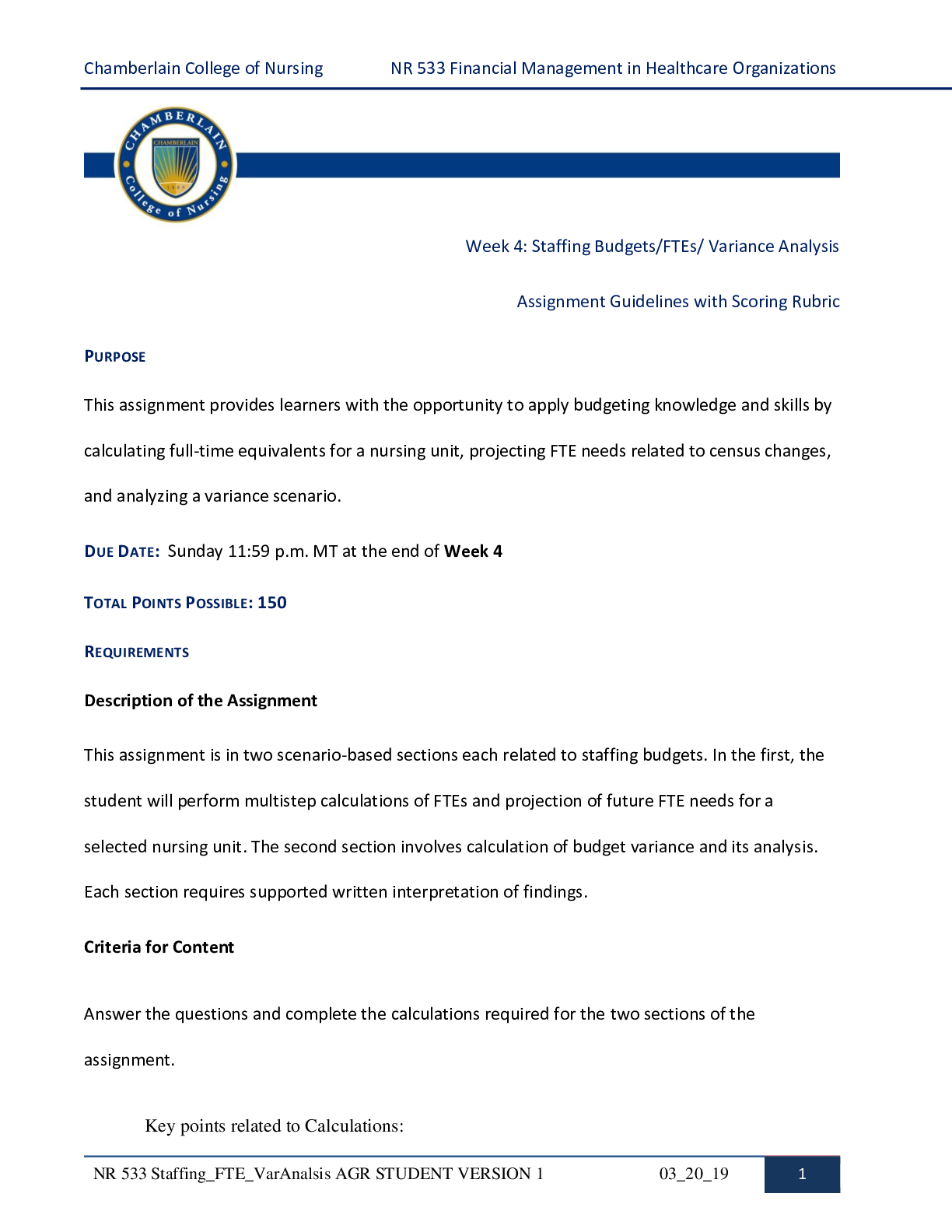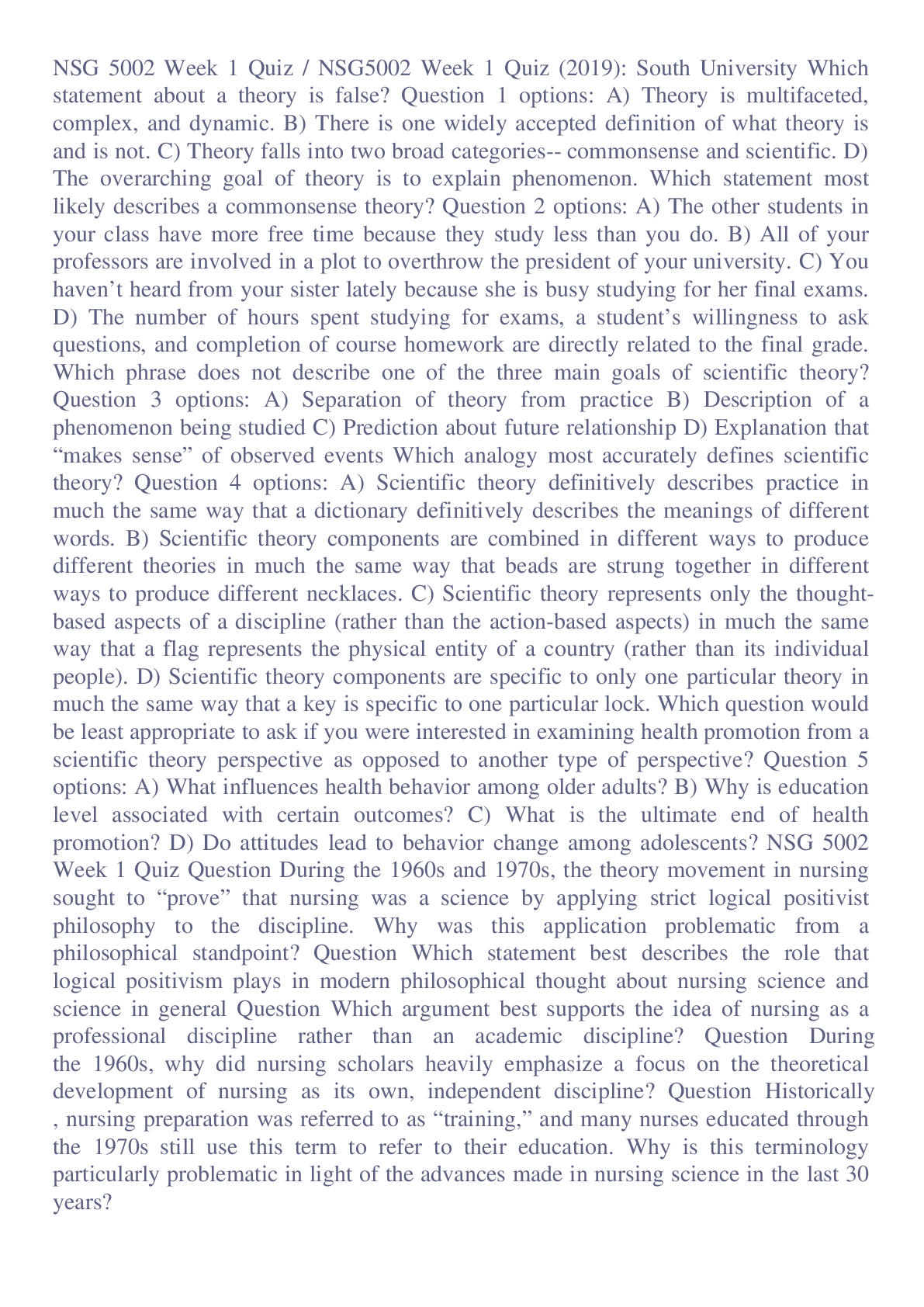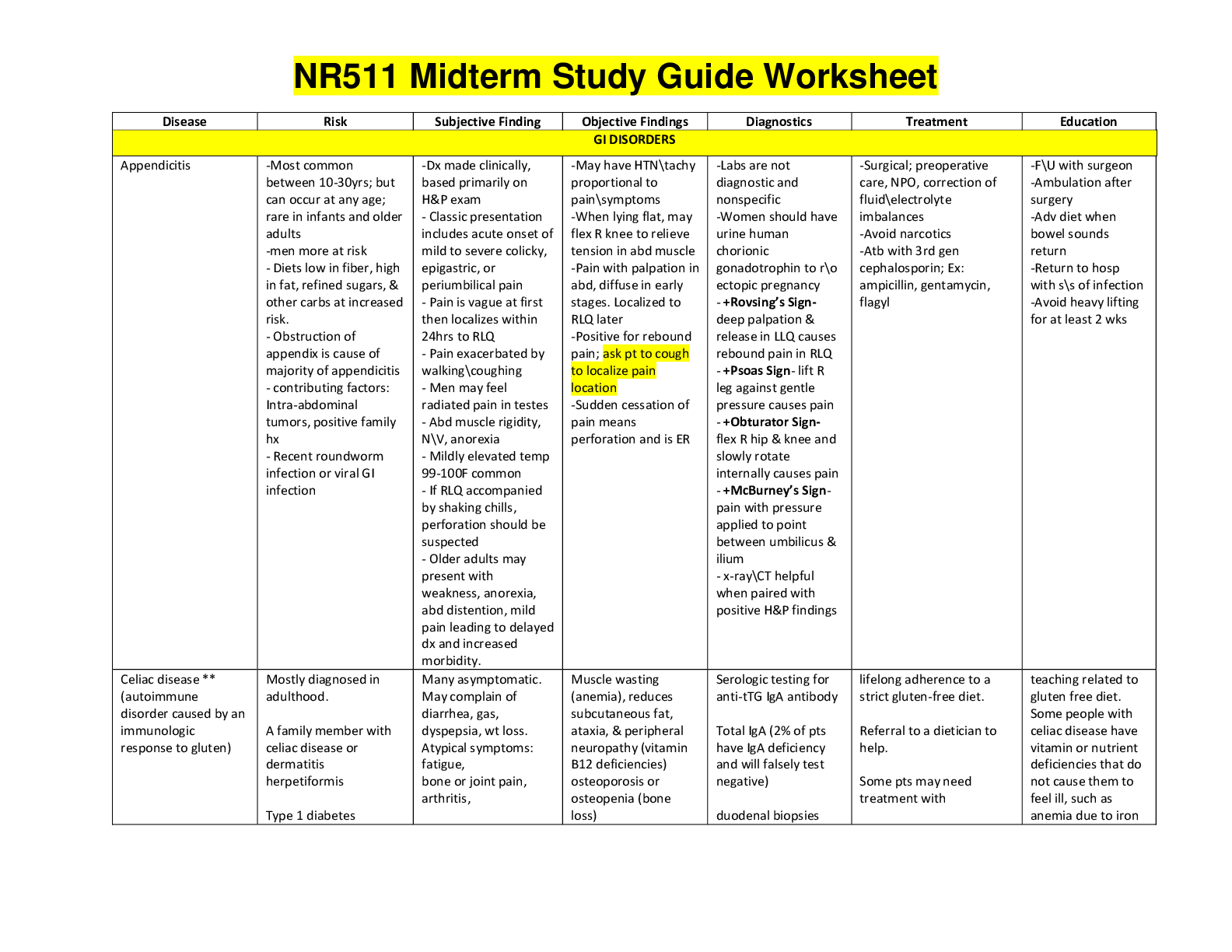*NURSING > STUDY GUIDE > ATI Mental Health ATI Questions Exam 1 Questions With VERIFIED; UPDATED LATEST ANSWERS (All)
ATI Mental Health ATI Questions Exam 1 Questions With VERIFIED; UPDATED LATEST ANSWERS
Document Content and Description Below
ATI Mental Health ATI Questions Exam 1 1.) A nurse is providing teaching for a client who is scheduled to receive ECT for the treatment of major depressive disorder. Which of the following client s... tatements indicates understanding of the teaching? a. “It is common to treat depression with ECT before trying medications.” b. “I can have my depression cured if I receive a series of ECT treatments.” c. “I should receive ECT once a week for 6 weeks.” d. “I will receive a muscle relaxant to protect me from injury during ECT.” 2.) A charge nurse is discussing TMS with a newly licensed nurse. Which of the following statements by the newly licensed nurse indicates an understanding of the teaching? a. “TMS is indicated for clients who have schizophrenia spectrum disorders.” b. “I will provide postanesthesia care following TMS.” c. “TMS treatments usually last 5 to 10 minutes.” d. “I will schedule the client for daily TMS treatments for the first several weeks.” 3.) A nurse is assessing a client immediately following an ECT procedure. Which of the following findings should the nurse expect? (Select all that apply.) a. Hypotension. b. Paralytic ileus. c. Memory loss. d. Nausea. e. Confusion. 4.) A nurse is leading a peer group discussion about the indications for ECT. Which of the following indications should the nurse include in the discussion? a. Borderline personality disorder. b. Acute withdrawal related to a substance use disorder. c. Bipolar disorder with rapid cycling. d. Dysphoric disorder. 5.) A nurse is planning care for a client following surgical implantation of a VNS device. The nurse should plan to monitor for which of the following adverse effects? (Select all that apply.) a. Voice changes. b. Seizure activity. c. Disorientation. d. Dysphagia. e. Neck pain. Chapter 16 Personality Disorders 1.) A nurse manager is discussing the care of a client who has a personality disorder with a newly licensed nurse. Which of the following statements by the newly licensed nurse indicates an understanding of the teaching? a. “I can promote my client’s sense of control by establishing a schedule.” b. “I should encourage clients who have a schizoid personality disorder to increase socialization.” c. “I should practice limit-setting to help prevent client manipulation.” d. “I should implement assertiveness training with clients who have antisocial personality disorder.” 2.) A nurse is caring for a client who has avoidant personality disorder. Which of the following statements is expected from a client who has this type of personality disorder? a. “I’m scared that you’re going to leave me.” b. “I’ll go to group therapy if you’ll let me smoke.” c. “I need to feel that everyone admires me.” d. “I sometimes feel better if I cut myself.” 3.) A nurse is caring for a client who has borderline personality disorder. The client says, “The nurse on the evening shift is always nice! You are the meanest nurse ever!” The nurse should recognize the client’s statement as an example of which of the following defense mechanisms? a. Regression. b. Splitting. c. Undoing. d. Identification. 4.) A nurse is assisting with a court-ordered evaluation of a client who has antisocial personality disorder. Which of the following findings should the nurse expect? (Select all that apply.) a. Demonstrates extreme anxiety when placed in a social situation. b. Has difficulty making even simple decisions. c. Attempts to convince other clients to give him their belongings. d. Becomes agitated if his personal area is not neat and orderly. e. Blames others for his past and current problems. 5.) A charge nurse is preparing a staff education session on personality disorders. Which of the following personality characteristics associated with all of the personality disorders should the charge nurse include in the teaching? a. Difficulty in getting along with other members of a group. b. Belief in the ability to become invisible during times of stress. c. Display of defense mechanisms when routines are changed. d. Claiming to be more important than other persons. e. Difficulty understanding why it is inappropriate to have a personal relationship with staff. Chapter 21 Medications for Anxiety and Trauma- and Stressor-Related Disorders 1.) A nurse working in a mental health clinic is providing teaching to a client who has a new prescription for diazepam for generalized anxiety disorder. Which of the following information should the nurse provide? a. Three to six weeks of treatment is required to achieve therapeutic benefit. b. Combining alcohol with diazepam will produce a paradoxical response. c. Diazepam has a lower risk for dependence than other antianxiety medications. d. Report confusion as a potential indication of toxicity. 2.) A nurse working in an emergency department is caring for a client who has benzodiazepine toxicity due to an overdose. Which of the following actions is the nurse’s priority? a. Administer flumazenil. b. Identify the client’s level of orientation. c. Infuse IV fluids. d. Prepare the client for gastric lavage. 3.) A nurse is caring for a client who is to begin taking fluoxetine for treatment of generalized anxiety disorder. Which of the following statements indicates the client understands the use of this medication? a. “I will take the medication at bedtime.” b. “I will follow a low-sodium diet while taking this medication.” c. “I will need to discontinue this medication slowly.” d. “I will be at risk for weight loss with long-term use of this medication.” 4.) A nurse is assessing a client 4 hr after receiving an initial dose of fluoxetine. Which of the following findings should the nurse report to the provider as indications of serotonin syndrome? (Select all that apply.) a. Hypothermia. b. Hallucinations. c. Muscular flaccidity. d. Diaphoresis. e. Agitation. 5.) A nurse is caring for a client who takes paroxetine to treat posttraumatic stress disorder. The client states that he grinds his teeth during the night, which causes pain in his mouth. The nurse should identify which of the following interventions as possible measures to manages the client’s bruxism? (Select all that apply.) a. Concurrent administration of buspirone. b. Administration of a different SSRI. c. Use of a mouth guard. d. Changing to a different class of antianxiety medication. e. Increasing the dose of paroxetine. Chapter 22 Medications for Depressive Disorders 1.) A nurse is providing teaching to a client who has a new prescription for amitriptyline. Which of the following statements by the client indicates an understanding of the teaching? a. “While taking this medication, I’ll need to stay out of the sun to avoid a skin rash.” b. “I may feel drowsy for a few weeks after starting this medication.” c. “I cannot eat my favorite pizza with pepperoni while taking this medication.” d. “This medication will help me lose the weight that I have gained over the last year.” 2.) A nurse is caring for a client who is taking phenelzine. For which of the following adverse effects should the nurse monitor? (Select all that apply.) a. Elevated blood glucose levels. b. Orthostatic hypotension. c. Priapism. d. Headache. e. Bruxism. 3.) A nurse is reviewing the medical record of a client who has a new prescription for bupropion for depression. Which of the following findings is the priority for the nurse to report to the provider? a. The client has a family history of seasonal pattern depression. b. The client currently smokes 1.5 packs of cigarettes per day. c. The client had a motor vehicle crash last year and sustained a head injury. d. The client has a BMI of 25 and has gained 10 lb over the last year. 4.) A nurse is teaching a client who has a new prescription for imipramine how to minimize anticholinergic effects. Which of the following instructions should the nurse include in the teaching? (Select all that apply.) a. Void just before taking the medication. b. Increase the dietary intake of potassium c. Wear sunglasses when outside. d. Change positions slowly when getting up. e. Chew sugarless gum. 5.) A charge nurse is discussing mirtazapine with a newly licensed nurse. Which of the following statements by the newly licensed nurse indicates understanding? a. “This medication increases the release of serotonin and norepinephrine.” b. “I will need to monitor the client for hyponatremia while taking this medication.” c. “This medication is contraindicated for clients who have an eating disorder.” d. “Sexual dysfunction is a common adverse effect of this medication.” Chapter 23 Medications for Bipolar Disorders 1.) A nurse is caring for a client who is prescribed lithium therapy. The client states that he wants to take ibuprofen for osteoarthritis pain relief. Which of the following statements should the nurse make? a. “That is a good choice. Ibuprofen does not interact with lithium.” b. “Regular aspirin would be a better choice than ibuprofen.” c. “Lithium decreases the effectiveness of ibuprofen.” d. “The ibuprofen will make your lithium level fall too low.” 2.) A nurse is discussing early indications of toxicity with a client who has a new prescription for lithium carbonate for bipolar disorder. The nurse should include which of the following manifestations in the teaching? (Select all that apply.) a. Constipation. b. Polyuria. c. Rash. d. Muscle weakness. e. Tinnitus. 3.) A nurse is discussing routine follow-up needs with a client who has a new prescription for valproate. The nurse should inform the client of the need for routine monitoring of which of the following? a. AST/ALT and LDH. b. Creatinine and BUN. c. WBC and granulocyte counts. d. Serum sodium and potassium. 4.) A nurse is caring for a client who is experiencing extreme mania due to bipolar disorder. Prior to administration of lithium carbonate, the client’s lithium blood level is 1.2 mEq/L. Which of the following actions should the nurse take? a. Administer the next dose of lithium carbonate as scheduled. b. Prepare for administration of aminophylline. c. Notify the provider for a possible increase in the dosage of lithium carbonate. d. Request a stat repeat of the client’s lithium blood level. 5.) A nurse is admitting a client who has a new diagnosis of bipolar disorder and is scheduled to begin lithium therapy. When collecting a medical history from the client’s adult daughter, which of the following statements is the priority to report to the provider? a. “My mother has diabetes that is controlled by her diet.” b. “My mother recently completed a course of prednisone for acute bronchitis.” c. “My mother received her flu vaccine last month.” d. “My mother is currently on furosemide for her congestive heart failure.” Chapter 24 Medications for Psychotic Disorders 1.) A nurse is caring for a client who has schizophrenia and exhibits a lack of grooming and a flat affect. The nurse should anticipate a prescription of which of the following medications? a. Chlorpromazine. b. Thiothixene. c. Risperidone. d. Haloperidol. 2.) A nurse is caring for a client who takes ziprasidone. The client reports difficulty swallowing the oral medication and becomes extremely agitated with injectable administration. The nurse should contact the provider to discuss a change to which of the following medications? (Select all that apply.) a. Olanzapine. b. Quetiapine. c. Aripiprazole. d. Clozapine. e. Asenapine. 3.) A charge nurse is discussing manifestations of schizophrenia with a newly licensed nurse. Which of the following manifestations should the charge nurse identify as being effectively treated by first-generation antipsychotics? (Select all that apply.) a. Auditory hallucinations. b. Withdrawal from social situations. c. Delusions of grandeur. d. Severe agitation. e. Anhedonia. 4.) A nurse is assessing a client who is currently taking perphenazine. Which of the following findings should the nurse identify as an extrapyramidal symptom (EPS)? (Select all that apply.) a. Decreased level of consciousness. b. Drooling. c. Involuntary arm movements. d. Urinary retention. e. Continual pacing. 5.) A nurse is providing discharge teaching for a client who has schizophrenia and a new prescription for iloperidone. Which of the following client statements indicates understanding of the teaching? a. “I will be able to stop taking this medication as soon as I feel better.” b. “If I feel drowsy during the day, I will stop taking this medication and call my provider.” c. “I will be careful not to gain too much weight while taking this medication.” d. “This medication is highly addictive and must be withdrawn slowly.” Chapter 25 Medications for Children and Adolescents Who Have Mental Health Issues 1.) A nurse is teaching the parents of a child who has autism spectrum disorder and a new prescription for imipramine about indications of toxicity. Which of the following should the nurse include in the teaching? (Select all that apply.) a. Seizures. b. Agitation. c. Photophobia. d. Dry mouth. e. Irregular pulse. 2.) A nurse is providing teaching to an adolescent client who has a new prescription for clomipramine for OCD. Which of the following information should the nurse provide? a. Eat a diet high in fiber. b. Check temperature daily. c. Take medication first thing in the morning before eating. d. Add extra calories to the diet as between-meal snacks. 3.) A nurse is providing teaching to an adolescent client who is to begin taking atomoxetine for ADHD. The nurse should instruct the client to monitor for which of the following adverse effects? (Select all that apply.) a. Somnolence. b. Yellowing skin. c. Increased appetite. d. Fever. e. Malaise. 4.) A nurse is caring for a school age child who has conduct disorder and a new prescription for methylphenidate transdermal patches. Which of the following information should the nurse provide about the medication? a. Apply the patch once daily at bedtime. b. Place the patch carefully in a trash can after removal. c. Apply the transdermal patch to the anterior waist area. d. Remove the patch each day after 9 hr. 5.) A nurse is teaching a client who has intermittent explosive disorder about a new prescription for fluoxetine. Which of the following information should the nurse provide? (Select all that apply.) a. An adverse effect of this medication is CNS depression. b. Administer the medication in the morning. c. Monitor for weight loss while taking this medication. d. Therapeutic effects of this medication will take 1 to 3 weeks to fully develop. e. This medication blocks the synaptic reuptake of serotonin in the brain. Chapter 26 Medications for Substance Use Disorders 1.) A nurse is providing teaching to a client who has alcohol use disorder and a new prescription for carbamazepine. Which of the following information should the nurse include in the teaching? a. “This medication will help prevent seizures during alcohol withdrawal.” b. “Taking this medication will decrease your cravings for alcohol.” c. “This medication maintains your blood pressure at a normal level during alcohol withdrawal.” d. “Taking this medication will improve your ability to maintain abstinence from alcohol.” 2.) A nurse is assisting in the discharge planning for a client following alcohol detoxification. The nurse should anticipate prescriptions for which of the following medications to promote long-term abstinence from alcohol? (Select all that apply.) a. Lorazepam. b. Diazepam. c. Disulfiram. d. Naltrexone. e. Acamprosate. 3.) A nurse is evaluating a client’s understanding of a new prescription for clonidine for the treatment of opioid use disorder. Which of the following statements by the client indicates an understanding of the teaching? a. “Taking this medication will help reduce my craving for heroin.” b. “While taking this medication, I should keep a pack of sugarless gum.” c. “I can expect some diarrhea from taking this medicine.” d. “Each dose of this medication should be placed under my tongue to dissolve.” 4.) A nurse is teaching a client who has tobacco use disorder about the use of nicotine gum. Which of the following information should the nurse include in the teaching? a. Chew the gum for no more than 10 minutes. b. Rinse out the mouth immediately before chewing the gum. c. Avoid eating 15 minutes prior to chewing the gum. d. Use of the gum is limited to 90 days. 5.) A nurse is discussing the use of methadone with a newly licensed nurse. Which of the following statements by the newly licensed nurse indicates an understanding of the teaching? (Select all that apply.) a. “Methadone is a replacement for physical dependence to opioids.” b. “Methadone reduces the unpleasant effects associated with abstinence syndrome.” c. “Methadone can be used during opioid withdrawal and to maintain abstinence.” d. “Methadone increases the risk for acetaldehyde syndrome.” e. “Methadone must be prescribed and dispensed by an approved treatment center.” [Show More]
Last updated: 1 year ago
Preview 1 out of 8 pages
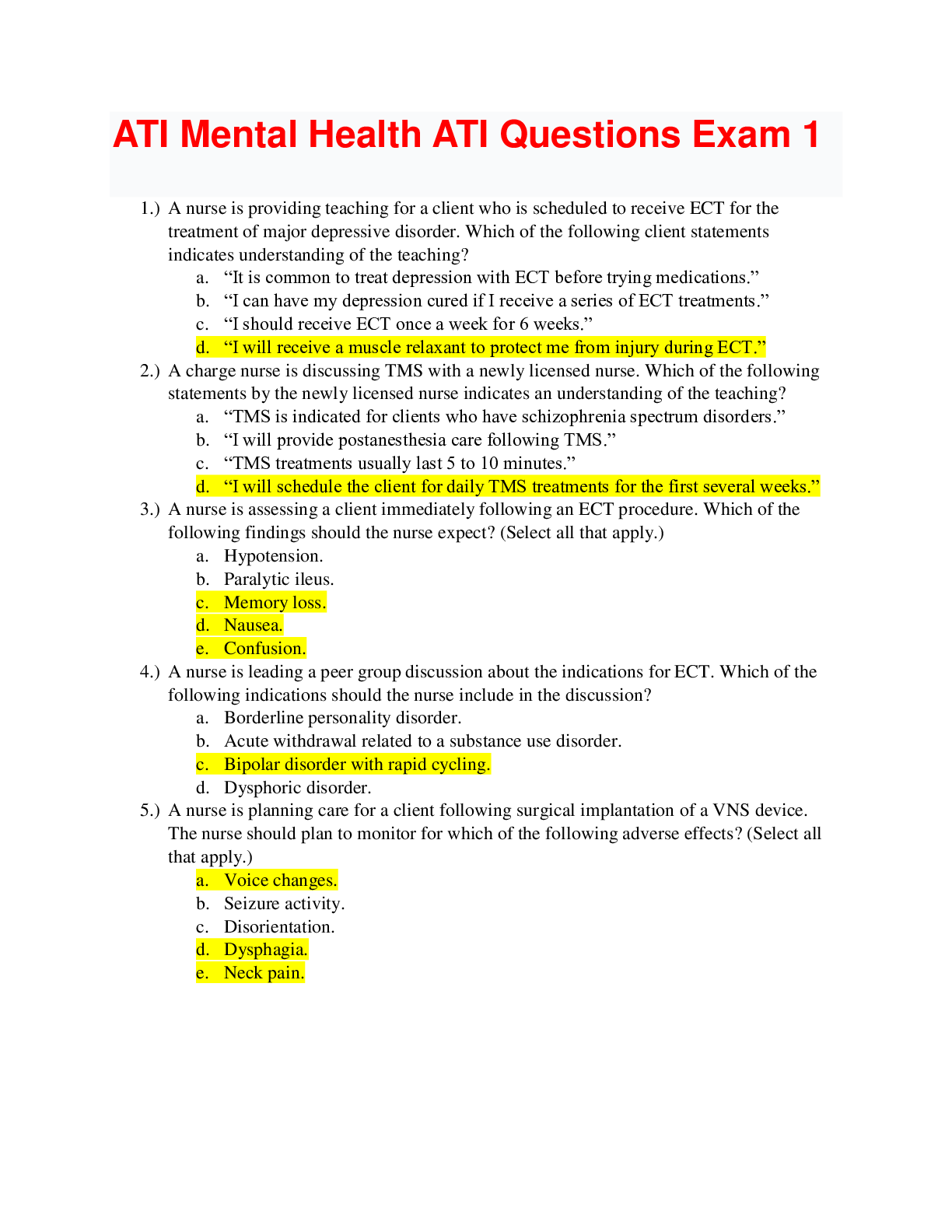
Reviews( 0 )
Document information
Connected school, study & course
About the document
Uploaded On
Aug 06, 2020
Number of pages
8
Written in
Additional information
This document has been written for:
Uploaded
Aug 06, 2020
Downloads
0
Views
41

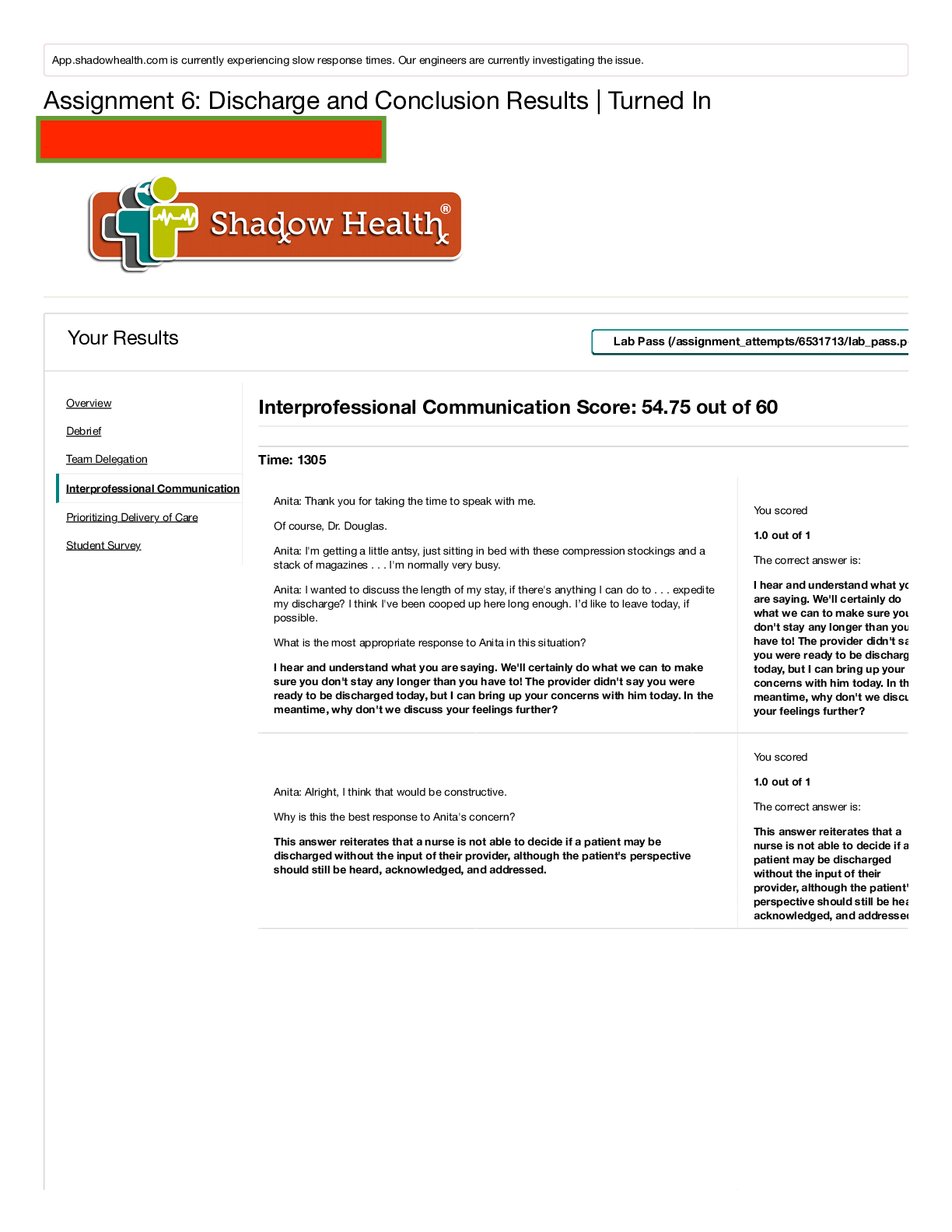
 Rasmussen College.png)

